May 7th 1942 , Battle of Coral Sea
The Battle of the Coral Sea, fought from May 4th-8th, 1942, was the first naval engagement in history where the opposing ships neither saw nor directly fired on each other. It also marked the end of Allied defensive-only activity, and paved the way for future Allied offensive operations.
This was the first of six battles between opposing aircraft carrier forces during the war. This battle resulted from American and Australian naval and air forces thwarting a Japanese amphibious operation intended to capture Port Moresby in New Guinea. A Japanese air base there would have threatened northeastern Australia and strategic sea lanes, possibly forcing Australia out of the war and certainly enhancing the strategic defenses of Japan's oceanic empire and further Japanese expansion into the Pacific.
The Japanese scored a tactical victory by sinking the aircraft carrier USS Lexington, heavily damaging the carrier USS Yorktown, and sinking a destroyer and an oiler. Against those losses, the Americans managed to achieve their first substantial kills against the Japanese Navy by sinking the light carrier Shoho and severely damaging the Shokaku, as well as damaging other smaller ships.
In truth the battle was an operational and strategic defeat for the Japanese--the first major check on their offensive sweep begun five months earlier at Pearl Harbor.
First, the invasion of Port Moresby was thwarted, boosting Allied chances in the bitterly fought New Guinea campaign, and fending off a threat to the supply lines running between the US and Australia. Second, the Japanese were denied the services of their two newest carriers on the eve of the Battle of Midway a month later. Historians have argued whether these two Japanese carriers would have actually been used at Midway; regardless, had these two carriers been available at Midway, things might well have turned out very differently for the Americans.
Elsewhere in the war
To put the importance and timing of this battle in context, we need to take a quick look at what else was happening in late April - early June 1942.
April 23rd was the beginning of the Luftwaffe's air attacks against the British cathedral cities.
On May 1st, General Carl Spaatz was designated commander of the Eighth Air Force, which had not yet left for England and was still Stateside at Bolling Field, Washington, DC.
On May 4th, US Navy aircraft attacked the Japanese invasion fleet at Tulagi Island, the first shots in what developed into the Battle of the Coral Sea.
Corregidor Island in the Philippines surrendered to the Japanese invaders on May 6th, ending US resistance in the Philippines.
May 7th marked the sinking of the Japanese light carrier Shoho by US Navy dive bombers, while the Japanese sank a US oiler and destroyer, mistaking them for a US carrier and cruiser. US Army Air Force bombers mistakenly attacked US ships, but caused no damage. During the day, the Japanese invasion force headed for Port Moresby turned back towards Rabaul.
May 8th was the day the US Navy lost the USS Lexington
May 8th was also the day the Germans began their Crimean offensive in Russia.
It was not until five days after the end of Coral Sea combat that the first 8th Air Force bomber squadron, minus its aircraft, reached England (May 13th).
June 4th-7th was the pivotal Battle of Midway, which truly turned the tide of the war in the Pacific.
The forces involved and the timeline
The Japanese campaign included two seaborne invasion forces, the main one aimed at Port Moresby, and a smaller one targeting Tulagi, in the Southern Solomons. These would be supported by Japanese land-based airpower from bases to the north and by two naval forces containing a small aircraft carrier, several cruisers, seaplane tenders and gunboats. Simultaneously, a powerful screening force built around the big carriers Shokaku and Zuikaku sortied from Truk to prevent interference from any Allied naval forces that might be in the area.
The U.S. Navy, tipped off to the enemy plans by superior communications intelligence and codebreaking, countered with two of its own carriers, plus cruisers (including two Australian cruisers), destroyers, submarines, land-based bombers and patrol seaplanes.
Sunday, May 3rd, 1942
On May 3rd, the smaller of the two Japanese naval forces made an unopposed landing at Tulagi in the southern Solomons. The small force of Australian commandos and airmen who had garrisoned Tulagi evacuated the previous day, having been notified by coastwatchers that the Japanese were en route.
While Tulagi was being occupied, the main force of the Japanese Fourth Fleet was completing its final preparations for the amphibious invasion of Port Moresby, which was scheduled to start on May 10th.
Monday, May 4th, 1942
The USS Yorktown, which had been refueling at Espiritu Santo, ran north and launched three air strikes against the Japanese shipping in Tulagi Harbor, hitting a destroyer and several small boats. It then returned southward to rejoin the Lexington.
Yorktown SBD aircraft return to their carrier after striking Japanese shipping in Tulagi harbor. Koei Maru is straddled by bombs while at anchor in Tulagi harbor during the attacks by Yorktown aircraft.
Meanwhile, long range, land-based bombers from General MacArthur's SWPA command were combing the seas for the Japanese convoy approaching Port Moresby, but failed to locate it either that day or the next.
Tuesday, May 5th, 1942
Allied intelligence reported that Port Moresby was the main enemy objective and that landings could be expected any time between May 5th and May 10th. B-17s and B-26s of the SWPA stood by for an attack order, while other planes carried out neutralizing raids to keep Japanese land-based air power from participating in the coming battle.
Wednesday, May 6th, 1942
It was not until late on the 6th, however, that three AAF B-17s finally located the Japanese invasion force headed for the Jomard Passage and the Louisiade Islands. US Rear Admiral Frank "Jack" Fletcher, Commander of the Allied Fleet, dispatched a group of cruisers and destroyers to cover the Jomard Passage, and moved north with his carrier force to contact and close with the main enemy fleet.
Thursday, May 7th, 1942
SBD-3, LTJG William E. Hall, VS-2, USS Lexington
Battle of the Coral Sea, May 7th-8th, 1942
The opposing commanders, Admiral Fletcher and Japanese Vice Admiral Takeo Takagi and Rear Admiral Tadaichi Hara, endeavored to strike the first blow, an essential tactic for victory (and survival) in a battle between heavily-armed and lightly-protected aircraft carriers.
However, both sides suffered from inadequate efforts by their scouts and launched massive air strikes that sank relatively unimportant secondary targets, while leaving the most important enemy forces untouched.
That morning, American scout planes reported sighting an enemy carrier, which proved to be the Shoho, and four heavy cruisers off Misima Island. Unfortunately, they were misreported as "two carriers and four heavy cruisers".
History Club
Military history and past events only. Rants or inflamitory comments will be removed.
Military history and past events only. Rants or inflamitory comments will be removed.
Hosted by Frank Amato
May 7th 1942 , Battle of Coral Sea

Lucky13

Member Since: June 01, 2006
entire network: 1,707 Posts
KitMaker Network: 530 Posts

Posted: Sunday, May 06, 2007 - 01:50 PM UTC

Lucky13

Member Since: June 01, 2006
entire network: 1,707 Posts
KitMaker Network: 530 Posts

Posted: Sunday, May 06, 2007 - 01:50 PM UTC
Ten B-17s were immediately sent to attack at high level. They were unsuccessful, but were able to start a fire on one cruiser. More important, by throwing the Japanese formation into complete disorder they caused the carrier to reverse its course.
Yorktown and Lexington sent a huge strike force of fifty-three scout-bombers, twenty-two torpedo planes and eighteen fighters. They caught the Japanese unprepared, with few planes in the air and with their carrier headed away from the wind. Nine bomb hits and four torpedoes sank the Shoho within five minutes after the first blow was struck.
A second strike aimed at the retiring enemy force was readied but not ordered aloft because the other Japanese carriers had not yet been located.
The undiscovered Shokaku and Zuikaku were meanwhile to the northeast, frantically searching for the American aircraft carriers. Japanese scouting planes from these two ships spotted the American oiler USS Neosho (AO 23) and her escort, the destroyer USS Sims (DD 409), before 8 AM, far to the south of Admiral Fletcher's carriers.
Misreported as a "carrier and a cruiser" by the Japanese scouts, the two ships were attacked twice by high-level bombers, but escaped unscathed.
However, about noon a large force of dive bombers appeared overhead, and they did not miss. Sims sank with very heavy casualties and Neosho was reduced to a drifting wreck whose survivors were not rescued for days. Admiral Fletcher did not learn of this attack until dusk, too late to take any effective counteraction.
Compounding the Japanese misunderstanding of the situation, Japanese land-based torpedo planes and bombers struck the force of Australian and American cruisers far to the west of Admiral Fletcher's carriers. Skillful ship handling prevented any damage to the Allied ships.
Adding to the general confusion, several Australia-based U.S. Army B-17s also arrived over the Allied ships and dropped their bombs, fortunately without hitting anything.
All this had one beneficial effect: the Japanese ordered their Port Moresby invasion force to turn back to await developments.
The Japanese learned of the sinking of the Shoho as their planes were returning from the attack on the tanker group, and at dusk about twenty-seven bombers and torpedo planes again left the Shokaku and Zuikaku in another effort to locate and sink the Lexington and the Yorktown.
After a long and fruitless search, the planes were forced to jettison their bombs and torpedoes and head back to their ships. During the return flight, these planes passed over the United States carriers at night and some landings were actually attempted before the Japanese pilots realized their mistake.
Almost none of the aircraft successfully returned to their carrier--a huge and wasteful loss of combat crews and aircraft.
Friday, May 8th, 1942
Before dawn on May 8th, both the Japanese and the American carriers dispatched scouting planes to locate their opponents. These made contact a few hours later, by which time the Japanese strike force was already airborne. The US aircraft launched soon after 9 AM, and task force commander Admiral Fletcher turned over tactical command to Rear Admiral Aubrey W. Fitch, who had more carrier experience.
Each side's planes attacked the other's ships at about 11 AM. While the Japanese ships were partially concealed by heavy weather, the American ships were operating under clear skies.
Planes from Yorktown hit the Shokaku, followed somewhat later by part of USS Lexington's air group. These attacks left Shokaku unable to launch planes, and she left the area soon after to return to Japan for repairs. Her sister ship, Zuikaku, was steaming nearby under low clouds and was not molested.
In addition to reconnaissance and preparatory raids against enemy air installations, Army Air Force land-based aircraft from the SWPA continued to support the action of the naval forces by flying some forty-five sorties against the enemy fleet. Bad weather intervened, however, and frustrated all attempts to bomb the crippled Shokaku, which succeeded in escaping to the sanctuary of Rabaul.
The "Lady Lex" goes down
The Japanese struck the American carriers in a fast and violent action, scoring torpedo hits on Lexington and with bombs on both carriers.
Lexington was struck by a torpedo to port. Moments later, a second torpedo hit to port directly abreast of the bridge. Simultaneously, she took three bomb hits from enemy dive bombers, and may have received as many as seven bomb and torpedo hits in all. These attacks left her with a 7 degree list to port and several raging fires.
By 1 PM her damage control parties had brought the fires under control and returned the ship to even keel; making 25 knots, she was ready to recover her air group. Suddenly and unexpectedly, Lexington was shaken by a tremendous explosion, caused by the ignition of gasoline vapors below decks, and again fire raged out of control.
At 4 PM, Capt. Frederick C. Sherman, fearing for the safety of his men working below decks, secured salvage operations, and ordered all hands to the flight deck. Admiral Fitch ordered "abandon ship" a few minutes after 5 PM, and the men began going over the side into the warm water to be immediately rescued by nearby cruisers and destroyers. This effort was so well executed that no additional sailors were lost in the rescue.
The now mortally wounded Lexington blazed on, flames shooting hundreds of feet into the air. Finally, the destroyer USS Phelps (DD 361) closed to 1500 yards, fired two torpedoes into the carrier's hull and the "Lady Lex" slid beneath the waves.
The Battle of Coral Sea ends
As May 8th drew to a close, both sides retired from the immediate battle area. In addition to the carriers and other ships lost, both sides experienced heavy aircraft losses. The US losses totaled 66 and postwar interrogations of Japanese survivors of the battle put Japanese aircraft losses much higher than 100.
Zuikaku returned to the area for a few days, even though her aircraft complement was badly depleted, but as the invasion of Port Moresby had been called off, she withdrew on May 11th. At about the same time USS Yorktown was recalled to Pearl Harbor. After receiving quick repairs, she would play a vital role in the Battle of Midway less than a month later.
Conclusion
The Battle of the Coral Sea prevented the Japanese from occupying Port Moresby by sea and temporarily delayed their plans to capture Guadalcanal and occupy the Solomons.
The Allies gained time in their race to improve defenses in New Guinea and northeastern Australia.
Truthfully, the American victory was purely defensive. Allied forces in the Southwest Pacific were still unable to launch a major offensive. The Japanese had lost an important battle, but the strategic initiative still remained in their hands--at least until the pivotal Battle of Midway just a month away.
Yorktown and Lexington sent a huge strike force of fifty-three scout-bombers, twenty-two torpedo planes and eighteen fighters. They caught the Japanese unprepared, with few planes in the air and with their carrier headed away from the wind. Nine bomb hits and four torpedoes sank the Shoho within five minutes after the first blow was struck.
A second strike aimed at the retiring enemy force was readied but not ordered aloft because the other Japanese carriers had not yet been located.
The undiscovered Shokaku and Zuikaku were meanwhile to the northeast, frantically searching for the American aircraft carriers. Japanese scouting planes from these two ships spotted the American oiler USS Neosho (AO 23) and her escort, the destroyer USS Sims (DD 409), before 8 AM, far to the south of Admiral Fletcher's carriers.
Misreported as a "carrier and a cruiser" by the Japanese scouts, the two ships were attacked twice by high-level bombers, but escaped unscathed.
However, about noon a large force of dive bombers appeared overhead, and they did not miss. Sims sank with very heavy casualties and Neosho was reduced to a drifting wreck whose survivors were not rescued for days. Admiral Fletcher did not learn of this attack until dusk, too late to take any effective counteraction.
Compounding the Japanese misunderstanding of the situation, Japanese land-based torpedo planes and bombers struck the force of Australian and American cruisers far to the west of Admiral Fletcher's carriers. Skillful ship handling prevented any damage to the Allied ships.
Adding to the general confusion, several Australia-based U.S. Army B-17s also arrived over the Allied ships and dropped their bombs, fortunately without hitting anything.
All this had one beneficial effect: the Japanese ordered their Port Moresby invasion force to turn back to await developments.
The Japanese learned of the sinking of the Shoho as their planes were returning from the attack on the tanker group, and at dusk about twenty-seven bombers and torpedo planes again left the Shokaku and Zuikaku in another effort to locate and sink the Lexington and the Yorktown.
After a long and fruitless search, the planes were forced to jettison their bombs and torpedoes and head back to their ships. During the return flight, these planes passed over the United States carriers at night and some landings were actually attempted before the Japanese pilots realized their mistake.
Almost none of the aircraft successfully returned to their carrier--a huge and wasteful loss of combat crews and aircraft.
Friday, May 8th, 1942
Before dawn on May 8th, both the Japanese and the American carriers dispatched scouting planes to locate their opponents. These made contact a few hours later, by which time the Japanese strike force was already airborne. The US aircraft launched soon after 9 AM, and task force commander Admiral Fletcher turned over tactical command to Rear Admiral Aubrey W. Fitch, who had more carrier experience.
Each side's planes attacked the other's ships at about 11 AM. While the Japanese ships were partially concealed by heavy weather, the American ships were operating under clear skies.
Planes from Yorktown hit the Shokaku, followed somewhat later by part of USS Lexington's air group. These attacks left Shokaku unable to launch planes, and she left the area soon after to return to Japan for repairs. Her sister ship, Zuikaku, was steaming nearby under low clouds and was not molested.
In addition to reconnaissance and preparatory raids against enemy air installations, Army Air Force land-based aircraft from the SWPA continued to support the action of the naval forces by flying some forty-five sorties against the enemy fleet. Bad weather intervened, however, and frustrated all attempts to bomb the crippled Shokaku, which succeeded in escaping to the sanctuary of Rabaul.
The "Lady Lex" goes down
The Japanese struck the American carriers in a fast and violent action, scoring torpedo hits on Lexington and with bombs on both carriers.
Lexington was struck by a torpedo to port. Moments later, a second torpedo hit to port directly abreast of the bridge. Simultaneously, she took three bomb hits from enemy dive bombers, and may have received as many as seven bomb and torpedo hits in all. These attacks left her with a 7 degree list to port and several raging fires.
By 1 PM her damage control parties had brought the fires under control and returned the ship to even keel; making 25 knots, she was ready to recover her air group. Suddenly and unexpectedly, Lexington was shaken by a tremendous explosion, caused by the ignition of gasoline vapors below decks, and again fire raged out of control.
At 4 PM, Capt. Frederick C. Sherman, fearing for the safety of his men working below decks, secured salvage operations, and ordered all hands to the flight deck. Admiral Fitch ordered "abandon ship" a few minutes after 5 PM, and the men began going over the side into the warm water to be immediately rescued by nearby cruisers and destroyers. This effort was so well executed that no additional sailors were lost in the rescue.
The now mortally wounded Lexington blazed on, flames shooting hundreds of feet into the air. Finally, the destroyer USS Phelps (DD 361) closed to 1500 yards, fired two torpedoes into the carrier's hull and the "Lady Lex" slid beneath the waves.
The Battle of Coral Sea ends
As May 8th drew to a close, both sides retired from the immediate battle area. In addition to the carriers and other ships lost, both sides experienced heavy aircraft losses. The US losses totaled 66 and postwar interrogations of Japanese survivors of the battle put Japanese aircraft losses much higher than 100.
Zuikaku returned to the area for a few days, even though her aircraft complement was badly depleted, but as the invasion of Port Moresby had been called off, she withdrew on May 11th. At about the same time USS Yorktown was recalled to Pearl Harbor. After receiving quick repairs, she would play a vital role in the Battle of Midway less than a month later.
Conclusion
The Battle of the Coral Sea prevented the Japanese from occupying Port Moresby by sea and temporarily delayed their plans to capture Guadalcanal and occupy the Solomons.
The Allies gained time in their race to improve defenses in New Guinea and northeastern Australia.
Truthfully, the American victory was purely defensive. Allied forces in the Southwest Pacific were still unable to launch a major offensive. The Japanese had lost an important battle, but the strategic initiative still remained in their hands--at least until the pivotal Battle of Midway just a month away.

Lucky13

Member Since: June 01, 2006
entire network: 1,707 Posts
KitMaker Network: 530 Posts

Posted: Sunday, May 06, 2007 - 02:02 PM UTC
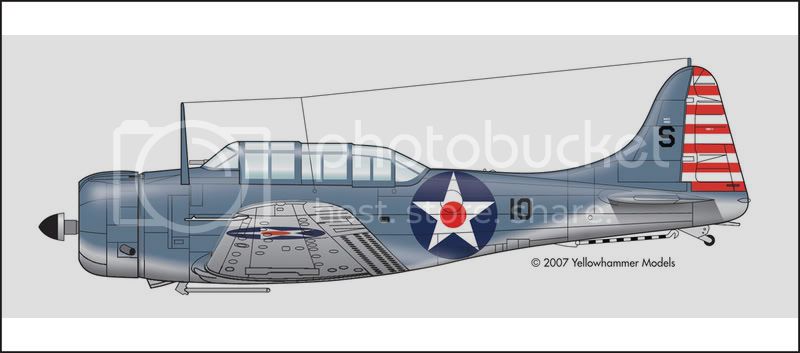
SBD-3, LTJG Stanley "Swede" Vejtasa, VS-5, USS Yorktown
Battle of the Coral Sea, May 4th-8th, 1942
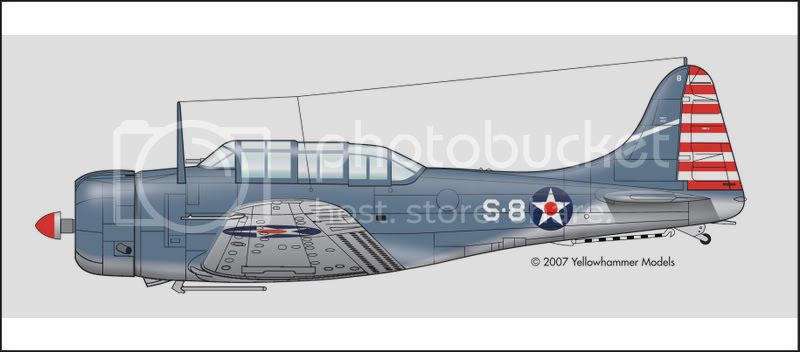
SBD-3, LTJG William E. Hall, VS-2, USS Lexington
Battle of the Coral Sea, May 7th-8th, 1942
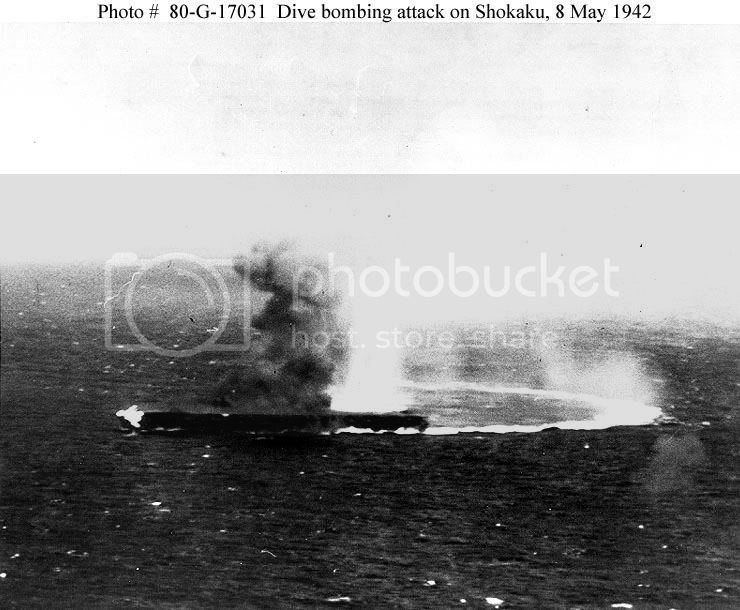



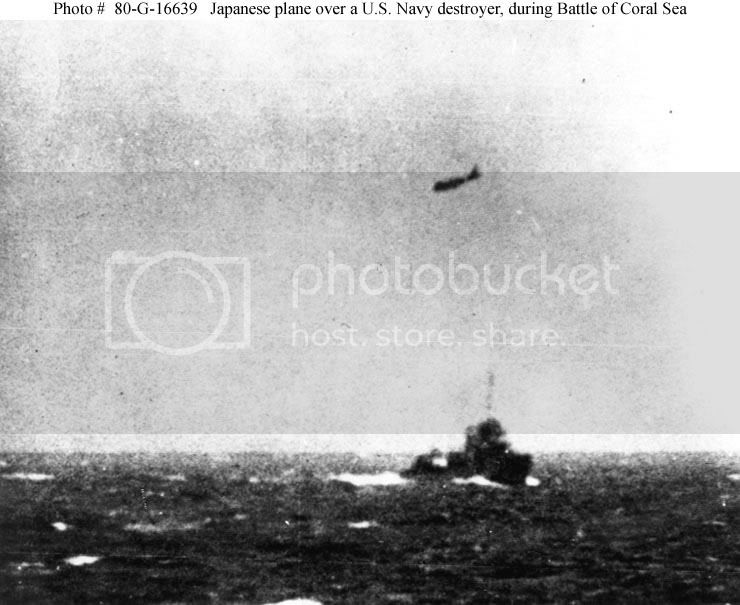


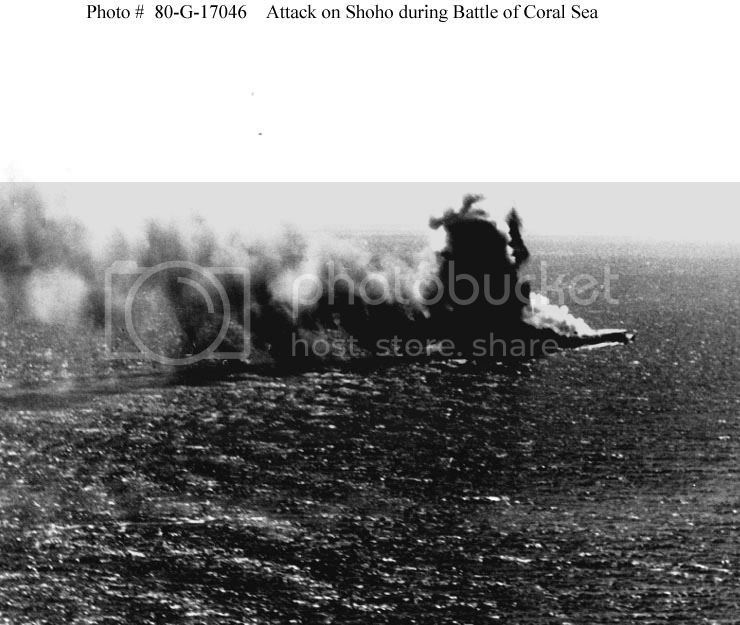
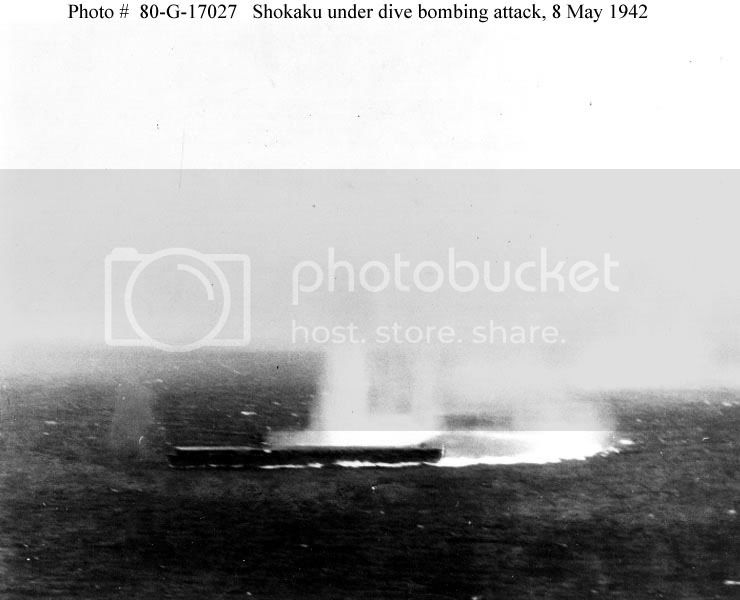
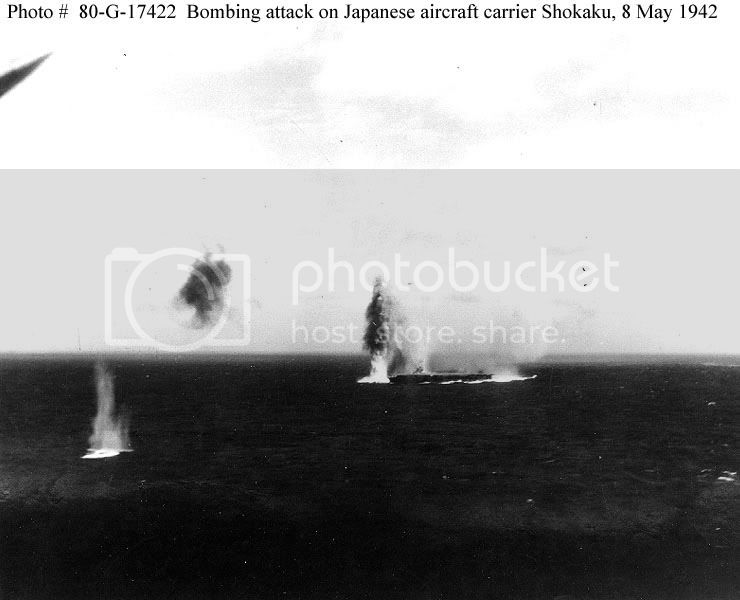
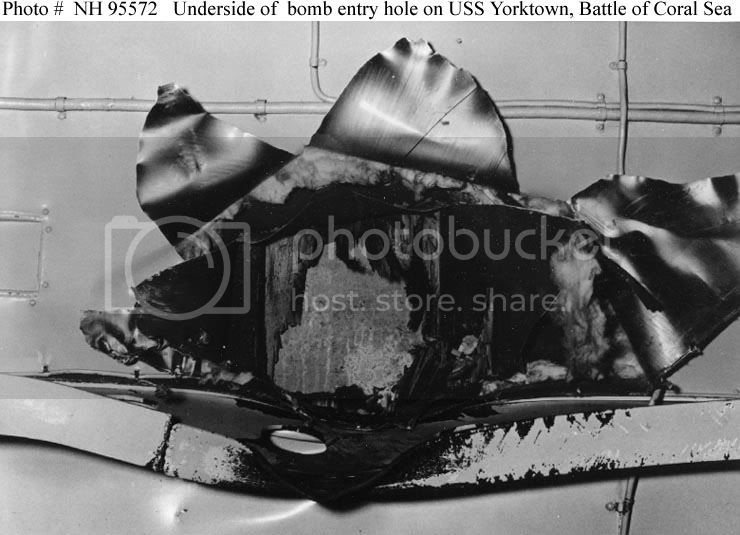
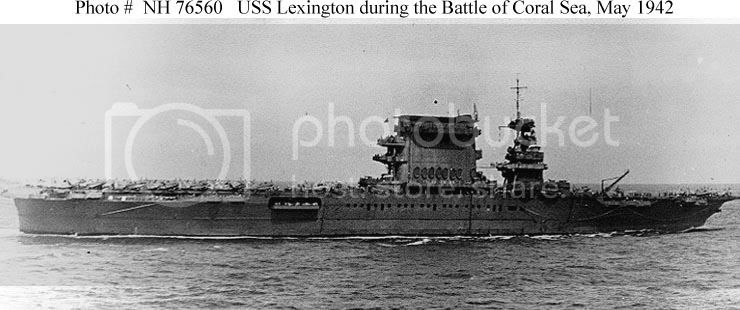

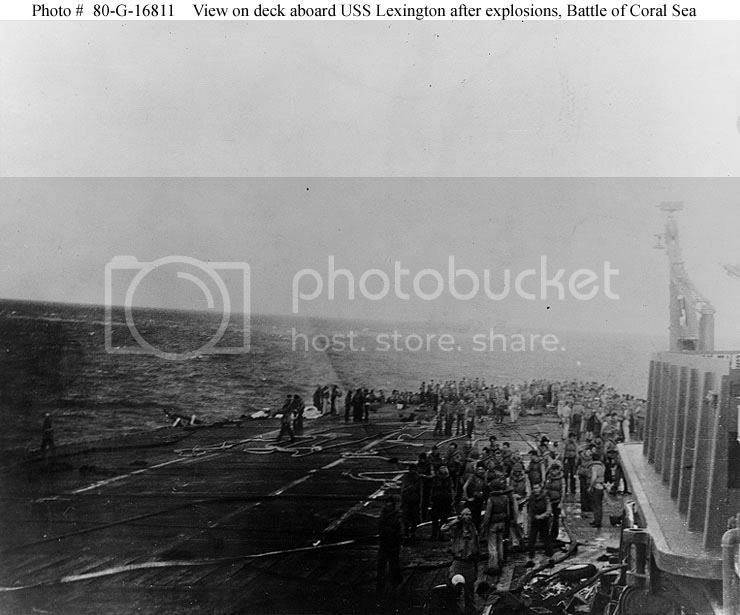
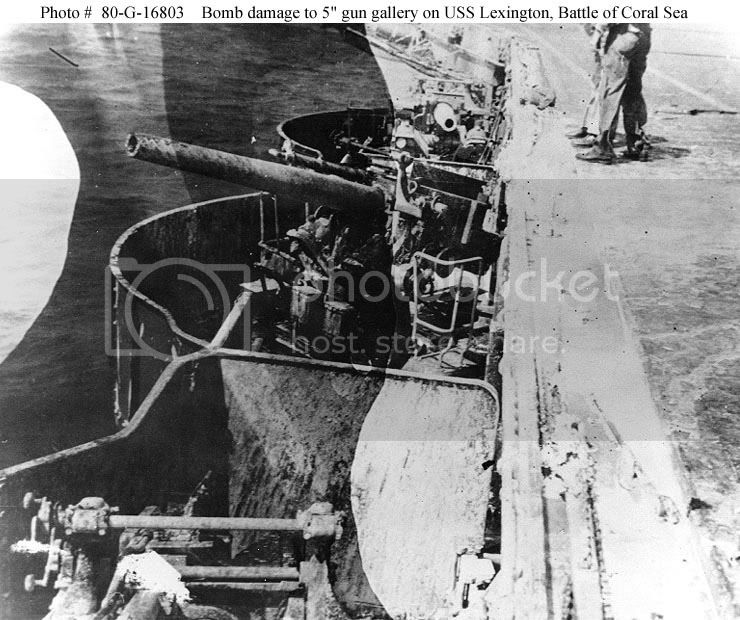
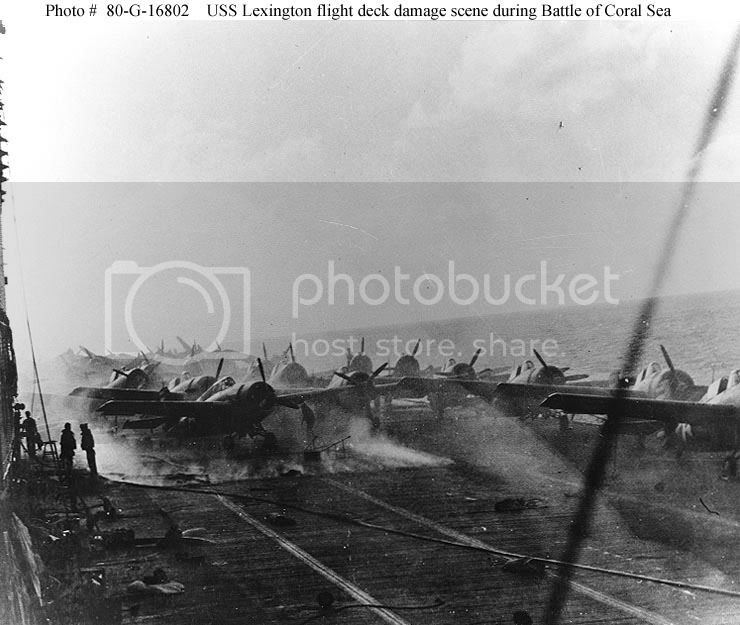
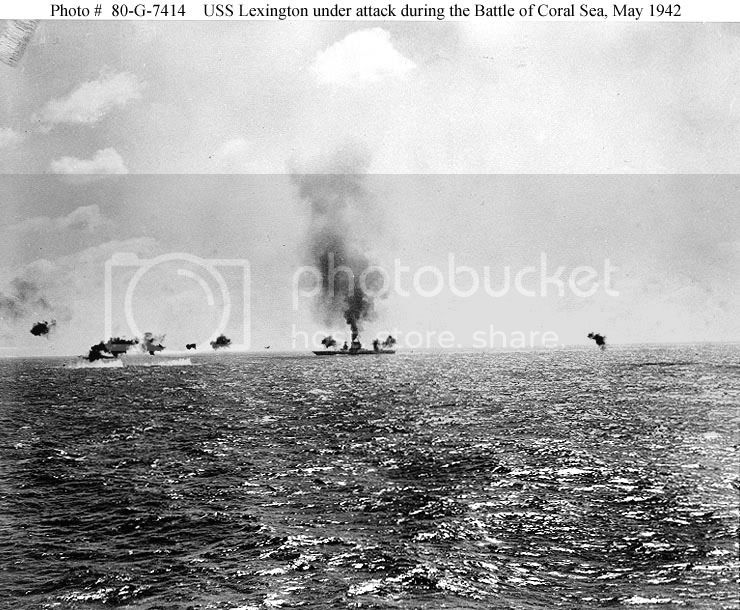
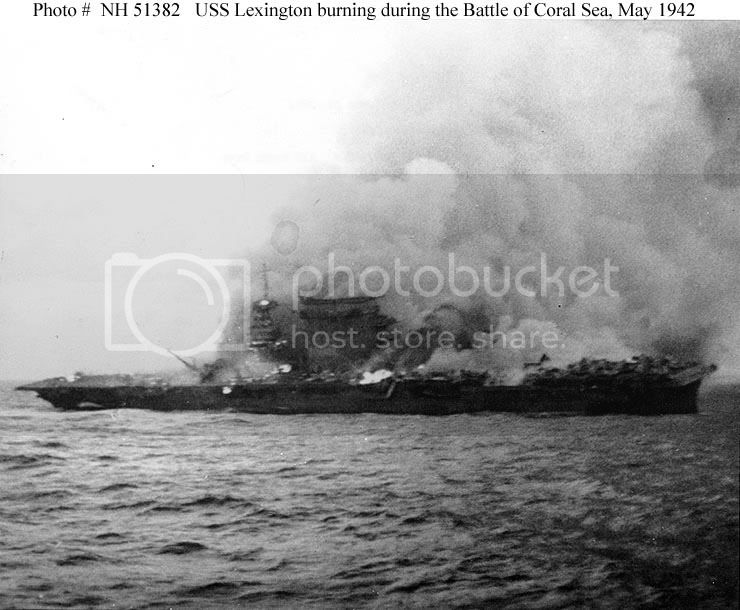
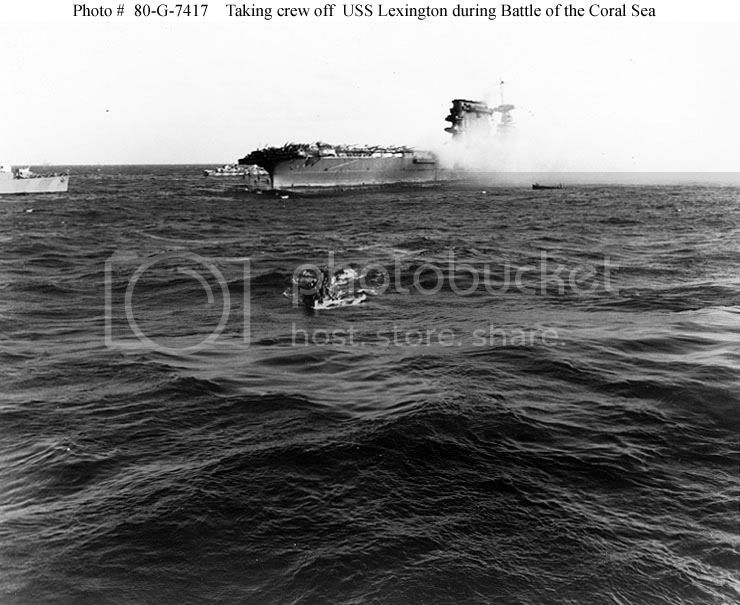
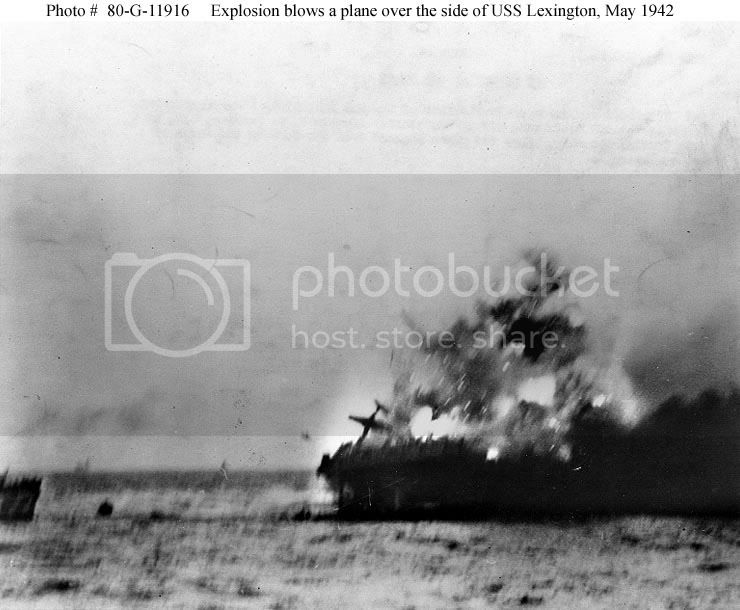
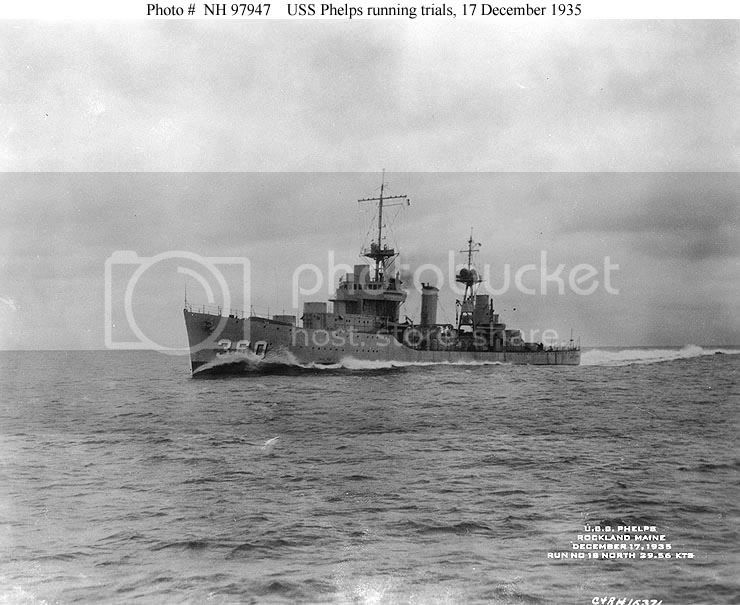
wildspear

Member Since: April 03, 2007
entire network: 960 Posts
KitMaker Network: 43 Posts

Posted: Sunday, May 06, 2007 - 03:24 PM UTC
Lucky13,
Very good read about the battle. I love reading about the battles of the war and the pic's were great.
Very good read about the battle. I love reading about the battles of the war and the pic's were great.

Brigandine

Member Since: July 12, 2006
entire network: 553 Posts
KitMaker Network: 148 Posts

Posted: Sunday, May 06, 2007 - 05:22 PM UTC
Thanks Lucky13: The Coral Sea battle was the start of the fightback at sea that eventually destroyed the Imperial Japanese Navy. It was also the first time that all the major combatants were out of sight of one another...and marked the end of the Battleship as THE major naval unit, around which naval tactics were based.
Halfyank

Member Since: February 01, 2003
entire network: 5,221 Posts
KitMaker Network: 1,983 Posts

Posted: Sunday, May 06, 2007 - 06:35 PM UTC
Very nice article Jan. These early battles, where the forces are fairly equal and the outcome is certainly in doubt, are to me much more interesting than the later battles with overwhelming superiority.
I'm currently reading a book about the cruiser USS Portland that was at Coral Sea, along with Midway, Guadalcanal, and most of the battles of the Pacific war. She was for a time considered an unlucky ship because each time she escorted a carrier, Lexington, Yorktown, Wasp, Hornet, the carrier was sunk.
What is interesting about the Lexington was how quickly she recovered from such damage. Hit by at least two torpedoes and three bombs she recovers enough to make 25 knots, only to be done in by fumes. She was a critical factor in the loss of many carriers in the war, fumes building up to the point of ignition.
I'm currently reading a book about the cruiser USS Portland that was at Coral Sea, along with Midway, Guadalcanal, and most of the battles of the Pacific war. She was for a time considered an unlucky ship because each time she escorted a carrier, Lexington, Yorktown, Wasp, Hornet, the carrier was sunk.
What is interesting about the Lexington was how quickly she recovered from such damage. Hit by at least two torpedoes and three bombs she recovers enough to make 25 knots, only to be done in by fumes. She was a critical factor in the loss of many carriers in the war, fumes building up to the point of ignition.

Lucky13

Member Since: June 01, 2006
entire network: 1,707 Posts
KitMaker Network: 530 Posts

Posted: Sunday, May 06, 2007 - 07:45 PM UTC
Thanks fellas! Some more.....
CV5/A15-3
(066) U.S.S. YORKTOWN
c/o Postmaster,
San Francisco, California.
May 16, 1942.
From: The Commanding Officer.
To: The CommanderTask Group Seventeen point Five.
Subject: Air Operations of Yorktown Air Group against Japanese Forces in the vicinity of the Louisiade Archipelago on May 8, 1942.
Enclosure: (A) Yorktown Air Group Commander's report of section for May 8, 1942.
Forwarded herewith is an advance copy of the report of action of the Yorktown Air Group for May 8, 1942.
This copy is forwarded in advance of the complete report in order that information contained in it may be immediately available to Commander Task Group 17.5.
Enclosure A
CYAG/A16-3
(02) U.S.S. YORKTOWN May 16, 1942.
From: The Commander, Yorktown Air Group.
To: The Commanding Officer.
Subject: Air Operations of Yorktown Air Group against Japanese Forces in the vicinity of the LOUISIADE ARCHIPELAGO on May 8, 1942.
Enclosures: (A) Sketch of Disposition of Enemy Force.
(B) Radar Plot of Contacts for May 8, 1942.
(C) Photographs taken on Attack (1 to 11).
This report, where it pertains to aircraft operations, was compiled from the narratives submitted by the personnel participating in the attack.
Task Organization of Air Group
Air Group Commander, Lt.Comdr. Oscar Pederson, USN.
VT-5 - 9 TBD's - Lt.Comdr. J. Taylor, USN.
VS-5 - 15 SBD's - Lt.Comdr. W.O. Burch, jr., USN.
VF-42 - 14 F4F-3's - Lt.Comdr. C.R. Fenton, USN.
VB-5 - 15 SBD's - Lieut. W.C. Short, jr., USN.
Weather
Yorktown was operating to the south of a frontal zone in an area of light haze with one to three tenths cumulus, base 1500 feet and top 6000 feet, visibility was 12 - 17 miles, winds were E. to ESE. 17 - 23 knots.
At the enemy position, a frontal area, which had been in our vicinity the day before, gave squally weather. The visibility varied from 2 to 15 miles. Winds were ESE, 15 - 20 knots. Cumulus, Alto-cumulus, and Cirrus clouds covered the area. The cloud cover and squally weather aided one CV to avoid attack but it also helped our planes to escape enemy fighters.
Attack Group
At 0828, on May 8, received word that a Lexington scout had made contact with an enemy force consisting of 2 CV's, 4 CA's, and many DD's. At 0847, received message from Lexington stating enemy bearing 028°, distance 175 miles. At 0848 received orders from Commander Air to launch the Attack Group. Commenced launching at 0900, completed launching at 0915. The Attack Group consisted of 6 VF, 7 VS, 15 VB, and 9 VT. The VS and VB planes were armed with Mark 13 - 1,000 lb. bombs, fuses Mark 21 and 23, and the torpedo planes with Mark 13 Mod. 1 torpedoes set to run at 10 feet. The VS and VB planes, escorted by 2 VF, proceeded toward the contact, climbing to 17,000 feet enroute. The dive bombers sighted the enemy force at about 1032. It consisted of 1 BB (Ise class), 2 CV's, 6 CA's, and 4 CL's or DD's on course 190°, speed 20 knots, disposition as shown in enclosure (A). The weather was squally with some rain squalls and a broken lower layer of clouds at 2 - 3000 feet.
At 1049 the planes were over the enemy ships and commenced circling waiting for the torpedo planes to arrive and take position for the attack. While the planes were circling 1 CV headed for a large rain squall; the other turned into the wind and commenced launching planes, some of the ships commenced firing their AA guns. At 1058 the torpedo planes were in position and a coordinated attack by dive bombers and torpedo planes was commenced. The dive bombing attack was made from 17,000 feet, down wind, altitude of release 2,500 feet. The CV maneuvered violently to avoid the attack. It was observed that five certain bomb hits, and a probablity of two more were made. The planes encountered considerable AA fire and were attacked by Zero fighters, both in the dive and on the pull out. It was noted that the fighters would attack until the planes joined up and then desisted. The numerous low clouds in the vicinity were used to good advantage to furnish protection when pursued by enemy fighters. In the ensuing action after the attack, VS-5 shot down two Zero fighters and damaged seven others, and VB-5 shot down three and damaged five. The dive bombers were again seriously handicapped by the fogging of their telescopes and windshields; unless the weather is clear, the telescopes and windshields will invariably fog. It is imperative that some action be taken on this as it greatly reduces the bombing efficiency of the SBD's.
The Torpedo Squadron proceeded to the contact point and commenced their approach from a SE direction. As the dive bombers commenced the attack, the carrier commenced turning to the left and then reversed the turn sharply to the right; it was during this turn that the torpedo planes dropped. The torpedo planes approached in a loose echelon of divisions, with the planes in each division in columns; on reaching the attack point the planes of the division turned simultaneously towards the CV and from this point on each pilot made an individual run. The AA fire from the CV and other ships was very heavy during the approach and attack. The retirement, to avoid enemy aircraft, was made to the eastward into a large cumulus cloud. Of the nine torpedoes dropped, three hit the objective, and three others were seen to run erratic.
It is estimated that the enemy had a Combat Air Patrol of at least 15 to 18 Zero fighters over the two CV's. A major factor in keeping our losses to a minimum was the close proximity of two large cumulus clouds into which our planes flew as soon as they completed their attack.
The escort fighters for the torpedo planes drove off an attack of six Zero fighters during the approach, and permitted the torpedo planes to make their drops unmolested by enemy aircraft. During the attack the escort fighters shot down three Zero fighters and one VSB while returning to the ship. The VSB escort fighters were greatly hampered in carrying out their mission by the necessity of conserving fuel, having had to climb to altitude with the bombers. On the return trip, the fighters attacked two enemy dive bombers, one of which gave out a puff of smoke and commenced gliding towards the water, leaving a small trail of vapor. It is not known whether this plane crashed.
When the attack Group left the vicinity of the enemy, the CV attacked was afire on the bow and aft of the island.
CV5/A15-3
(066) U.S.S. YORKTOWN
c/o Postmaster,
San Francisco, California.
May 16, 1942.
From: The Commanding Officer.
To: The CommanderTask Group Seventeen point Five.
Subject: Air Operations of Yorktown Air Group against Japanese Forces in the vicinity of the Louisiade Archipelago on May 8, 1942.
Enclosure: (A) Yorktown Air Group Commander's report of section for May 8, 1942.
Forwarded herewith is an advance copy of the report of action of the Yorktown Air Group for May 8, 1942.
This copy is forwarded in advance of the complete report in order that information contained in it may be immediately available to Commander Task Group 17.5.
Enclosure A
CYAG/A16-3
(02) U.S.S. YORKTOWN May 16, 1942.
From: The Commander, Yorktown Air Group.
To: The Commanding Officer.
Subject: Air Operations of Yorktown Air Group against Japanese Forces in the vicinity of the LOUISIADE ARCHIPELAGO on May 8, 1942.
Enclosures: (A) Sketch of Disposition of Enemy Force.
(B) Radar Plot of Contacts for May 8, 1942.
(C) Photographs taken on Attack (1 to 11).
This report, where it pertains to aircraft operations, was compiled from the narratives submitted by the personnel participating in the attack.
Task Organization of Air Group
Air Group Commander, Lt.Comdr. Oscar Pederson, USN.
VT-5 - 9 TBD's - Lt.Comdr. J. Taylor, USN.
VS-5 - 15 SBD's - Lt.Comdr. W.O. Burch, jr., USN.
VF-42 - 14 F4F-3's - Lt.Comdr. C.R. Fenton, USN.
VB-5 - 15 SBD's - Lieut. W.C. Short, jr., USN.
Weather
Yorktown was operating to the south of a frontal zone in an area of light haze with one to three tenths cumulus, base 1500 feet and top 6000 feet, visibility was 12 - 17 miles, winds were E. to ESE. 17 - 23 knots.
At the enemy position, a frontal area, which had been in our vicinity the day before, gave squally weather. The visibility varied from 2 to 15 miles. Winds were ESE, 15 - 20 knots. Cumulus, Alto-cumulus, and Cirrus clouds covered the area. The cloud cover and squally weather aided one CV to avoid attack but it also helped our planes to escape enemy fighters.
Attack Group
At 0828, on May 8, received word that a Lexington scout had made contact with an enemy force consisting of 2 CV's, 4 CA's, and many DD's. At 0847, received message from Lexington stating enemy bearing 028°, distance 175 miles. At 0848 received orders from Commander Air to launch the Attack Group. Commenced launching at 0900, completed launching at 0915. The Attack Group consisted of 6 VF, 7 VS, 15 VB, and 9 VT. The VS and VB planes were armed with Mark 13 - 1,000 lb. bombs, fuses Mark 21 and 23, and the torpedo planes with Mark 13 Mod. 1 torpedoes set to run at 10 feet. The VS and VB planes, escorted by 2 VF, proceeded toward the contact, climbing to 17,000 feet enroute. The dive bombers sighted the enemy force at about 1032. It consisted of 1 BB (Ise class), 2 CV's, 6 CA's, and 4 CL's or DD's on course 190°, speed 20 knots, disposition as shown in enclosure (A). The weather was squally with some rain squalls and a broken lower layer of clouds at 2 - 3000 feet.
At 1049 the planes were over the enemy ships and commenced circling waiting for the torpedo planes to arrive and take position for the attack. While the planes were circling 1 CV headed for a large rain squall; the other turned into the wind and commenced launching planes, some of the ships commenced firing their AA guns. At 1058 the torpedo planes were in position and a coordinated attack by dive bombers and torpedo planes was commenced. The dive bombing attack was made from 17,000 feet, down wind, altitude of release 2,500 feet. The CV maneuvered violently to avoid the attack. It was observed that five certain bomb hits, and a probablity of two more were made. The planes encountered considerable AA fire and were attacked by Zero fighters, both in the dive and on the pull out. It was noted that the fighters would attack until the planes joined up and then desisted. The numerous low clouds in the vicinity were used to good advantage to furnish protection when pursued by enemy fighters. In the ensuing action after the attack, VS-5 shot down two Zero fighters and damaged seven others, and VB-5 shot down three and damaged five. The dive bombers were again seriously handicapped by the fogging of their telescopes and windshields; unless the weather is clear, the telescopes and windshields will invariably fog. It is imperative that some action be taken on this as it greatly reduces the bombing efficiency of the SBD's.
The Torpedo Squadron proceeded to the contact point and commenced their approach from a SE direction. As the dive bombers commenced the attack, the carrier commenced turning to the left and then reversed the turn sharply to the right; it was during this turn that the torpedo planes dropped. The torpedo planes approached in a loose echelon of divisions, with the planes in each division in columns; on reaching the attack point the planes of the division turned simultaneously towards the CV and from this point on each pilot made an individual run. The AA fire from the CV and other ships was very heavy during the approach and attack. The retirement, to avoid enemy aircraft, was made to the eastward into a large cumulus cloud. Of the nine torpedoes dropped, three hit the objective, and three others were seen to run erratic.
It is estimated that the enemy had a Combat Air Patrol of at least 15 to 18 Zero fighters over the two CV's. A major factor in keeping our losses to a minimum was the close proximity of two large cumulus clouds into which our planes flew as soon as they completed their attack.
The escort fighters for the torpedo planes drove off an attack of six Zero fighters during the approach, and permitted the torpedo planes to make their drops unmolested by enemy aircraft. During the attack the escort fighters shot down three Zero fighters and one VSB while returning to the ship. The VSB escort fighters were greatly hampered in carrying out their mission by the necessity of conserving fuel, having had to climb to altitude with the bombers. On the return trip, the fighters attacked two enemy dive bombers, one of which gave out a puff of smoke and commenced gliding towards the water, leaving a small trail of vapor. It is not known whether this plane crashed.
When the attack Group left the vicinity of the enemy, the CV attacked was afire on the bow and aft of the island.

Lucky13

Member Since: June 01, 2006
entire network: 1,707 Posts
KitMaker Network: 530 Posts

Posted: Sunday, May 06, 2007 - 07:45 PM UTC
Anti-Torpedo Plane Patrol
At 0730, on May 8, 1942, launched 8 SBD's of VS-5 to form an Anti-Torpedo Plane Patrol on orders of Commander Air. This patrol attempted to intercept the enemy torpedo planes, but they were too fast for them. They were then attacked by a large number of Type 97 and 00 fighters. In the melee that occurred, they shot down five fighters and damaged eight more. In the engagement, four of the SBD's were shot down by enemy aircraft and the remainder returned badly damaged by enemy fighter gunfire. This was a splendid example of courage and devotion to duty, although outnumbered and opposed by faster and more maneuverable aircraft, they were not outfought.
Combat Air Patrol
Fighter Director control was on the U.S.S. Lexington. At 0724 launched the first Combat Air Patrol. At 0804 an unidentified plane was picked up on the Radar screen, bearing 320°, distance 18 miles. Fighters were vectored out but did not make contact (see enclosure (B)) and it disappeared off the screen at 0811. At 0831, another unidentified plane was picked up coming in from bearing 083°, distance 30 miles. Fighters were vectored out but did not make contact. This plane disappeared off the screen at 15 miles, it is believed that it may have been a friendly plane as it never was picked up going away. At 0941 launched a relief Combat Air Patrol and landed the first group. At 1008 an enemy four engine patrol bomber was sighted by the Yorktown lookouts bearing 040° and flying at a low altitude. A section of Yorktown fighters was vectored out and shot it down.
Enclosure (B) shows the track of the enemy attack group. Insofar as possible, the below is an account of how the enemy attack was met by the Combat Air Patrol, as compiled from the radio log, Radar Plot, and the account of Lexington and Yorktown pilots available. At 1055, the Radar screen showed a very large group of enemy planes approaching the formation, bearing 020°, distance 68 miles. At 1059 all planes were recalled to the vicinity of the ship. At 1102 launched four
additional VF, making a total of 8 VF from the Yorktown and 9 VF from the Lexington on Combat Air Patrol. The designation of each of the two plane sections was as follows:
Lexington - Agnes Red (3 planes) and White, Doris Red and White.
Yorktown - Wildcat Red, Blue, Orange and Brown.
At 1102, 5 VF (Agnes Red and White) were vectored out on 020°, distance 30 miles, Angels 10. Later, Agnes White was told to go low to intercept torpedo planes. Agnes Red made contact with the enemy force about 20 miles out, they were 1 - 2000 feet below the enemy. One of these pilots stated that there were about 50 - 60 planes, stacked in layers extending from about 10,000 to 13,000 feet, approximately 1/3 of them being fighters. The lowest level was the torpedo planes and above them fighters, then dive bombers and fighters, in that order. Agnes Red attacked the enemy formation while they were about 15 to 20 miles from the Fleet. Agnes White, as shown from the radio log, attacked torpedo planes at 1116 about 4 to 5 miles from the Fleet. At 1108, 4 VF (Wildcat Red and Blue) were vectored out on 020°, distance 15 miles and Angels 1. Upon reaching this position and not sighting anything, instructions were requested. They were informed by the Lexington Fighter Director that the force was being attacked, and to return, climbing to 10,000 feet. They returned after the attack was over, but were able to attack some enemy planes in the vicinity and shot down one Zero fighter. Of the two remaining Lexington sections, it is believed that one section (Doris White) was over the ship and was there during the attack as no other orders were given to him. The other Lexington section (Doris Red) was told to orbit overhead, he climbed to 12,000 feet and attacked the tail end of the enemy formation. Wildcat Brown and Orange were kept over the ship at about 8 - 10,000 feet. The Orange section was not able to intercept the enemy before they attacked, but did shoot down one Zero fighter, and one dive bomber who had already released his bomb. The Brown section attacked a formation of dive bombers as they commenced their dive and went down with them, they shot down one dive bomber before it dropped its bomb and another afterwards.
A resume of the above shows that only three of the Combat Air Patrol intercepted the enemy at about 15 to 20 miles. The others were not in position to attack until after the enemy had commenced or finished his attack. The Yorktown Combat Air Patrol shot down two Zero fighters and three dive bombers. A Combat Air Patrol and Anti-Torpedo Plane Patrol was maintained for the remainder of the day.
Lexington Planes
Due to the breakdown of the U.S.S. Lexington, the following Lexington planes landed on board this ship:
6 F4F-3's and 13 SBD's, and have been retained on board.
Summary of Damage Done by Air group
Damage Inflicted on Enemy
One large CV damaged and possibly sunk by three torpedo hits, 5 - 1000 lb. bomb hits.
Shot down the following number of planes:
15 VF - Type 00 and 97.
4 VB - Believed to be Type 99, Navy dive bombers.
1 VP - Four engine patrol plane - Type 97.
Damaged the following number of planes:
20 VF - Type 00 and 97.
1 VB - Type 99, Navy dive bomber.
NOTE: It is believed that there is duplication between the number of planes shot down and the planes damaged
Damage Suffered by Air Group
Personnel missing in Air Action
6 Pilots.
6 Rear Seat Gunners.
Personnel Wounded in Air Action
4 Pilots.
3 Rear Seat Gunners.
Planes Missing in Action
2 F4F-3's (Pilots recovered)
7 SBD's (One pilot and passenger recovered)
Planes damaged in Action
1 TBD - Bullet hole in right wing.
3 VF - One had about 10 holes in fuselage, five of which passed through the emergency fuel tank and were stopped by the armor. One bullet hole in main fuel tank. One through the vacuum tank and one along left side which hit the instrument panel. This plane will require a major overhaul.
One had about thirty small caliber hits in tail and fuselage. Requires major overhaul.
One had one small caliber hole in left wing.
18 VSB - One was so badly damaged that it crashed on landing and was a total wreck.
Three require major overhaul, due to numerous 20 mm and 7.7 mm hits.
The remainder of the planes had anywhere from 1 to 26 hits in the fuselage, empenage, wings, gas tanks, and armor.
Leak Proof Gas Tanks:
A total of 20 self-sealing tanks were hit:
Three by one hit.
Eight by two hits.
Four by three hits.
Four by four hits.
One riddled by a direct hit on wing by a 20 mm explosive shell.
The only tank to develop a leak in the air was the last one, which leaked badly. Two others developed leaks later in the day.
Armor
The armor in three planes was struck with one to three small caliber bullets. In no case was the armor pierced.
Ammunition Expended:
VS-5 dropped 7 - 1000 lb. bombs, Mk. 13; fuses Mk. 21 and 23.
VB-5 dropped 15 - 1000 lb. bombs, Mk. 13; fuses Mk. 21 and 23.
VT-5 dropped 9 torpedoes, Mark 13, Mod. 1, set to run at 10 feet.
Expended 32,610 rounds of .50 caliber ammunition.
Expended 4,660 rounds of .30 caliber ammunition.
NOTE: Three torpedoes made erratic runs.
At 0730, on May 8, 1942, launched 8 SBD's of VS-5 to form an Anti-Torpedo Plane Patrol on orders of Commander Air. This patrol attempted to intercept the enemy torpedo planes, but they were too fast for them. They were then attacked by a large number of Type 97 and 00 fighters. In the melee that occurred, they shot down five fighters and damaged eight more. In the engagement, four of the SBD's were shot down by enemy aircraft and the remainder returned badly damaged by enemy fighter gunfire. This was a splendid example of courage and devotion to duty, although outnumbered and opposed by faster and more maneuverable aircraft, they were not outfought.
Combat Air Patrol
Fighter Director control was on the U.S.S. Lexington. At 0724 launched the first Combat Air Patrol. At 0804 an unidentified plane was picked up on the Radar screen, bearing 320°, distance 18 miles. Fighters were vectored out but did not make contact (see enclosure (B)) and it disappeared off the screen at 0811. At 0831, another unidentified plane was picked up coming in from bearing 083°, distance 30 miles. Fighters were vectored out but did not make contact. This plane disappeared off the screen at 15 miles, it is believed that it may have been a friendly plane as it never was picked up going away. At 0941 launched a relief Combat Air Patrol and landed the first group. At 1008 an enemy four engine patrol bomber was sighted by the Yorktown lookouts bearing 040° and flying at a low altitude. A section of Yorktown fighters was vectored out and shot it down.
Enclosure (B) shows the track of the enemy attack group. Insofar as possible, the below is an account of how the enemy attack was met by the Combat Air Patrol, as compiled from the radio log, Radar Plot, and the account of Lexington and Yorktown pilots available. At 1055, the Radar screen showed a very large group of enemy planes approaching the formation, bearing 020°, distance 68 miles. At 1059 all planes were recalled to the vicinity of the ship. At 1102 launched four
additional VF, making a total of 8 VF from the Yorktown and 9 VF from the Lexington on Combat Air Patrol. The designation of each of the two plane sections was as follows:
Lexington - Agnes Red (3 planes) and White, Doris Red and White.
Yorktown - Wildcat Red, Blue, Orange and Brown.
At 1102, 5 VF (Agnes Red and White) were vectored out on 020°, distance 30 miles, Angels 10. Later, Agnes White was told to go low to intercept torpedo planes. Agnes Red made contact with the enemy force about 20 miles out, they were 1 - 2000 feet below the enemy. One of these pilots stated that there were about 50 - 60 planes, stacked in layers extending from about 10,000 to 13,000 feet, approximately 1/3 of them being fighters. The lowest level was the torpedo planes and above them fighters, then dive bombers and fighters, in that order. Agnes Red attacked the enemy formation while they were about 15 to 20 miles from the Fleet. Agnes White, as shown from the radio log, attacked torpedo planes at 1116 about 4 to 5 miles from the Fleet. At 1108, 4 VF (Wildcat Red and Blue) were vectored out on 020°, distance 15 miles and Angels 1. Upon reaching this position and not sighting anything, instructions were requested. They were informed by the Lexington Fighter Director that the force was being attacked, and to return, climbing to 10,000 feet. They returned after the attack was over, but were able to attack some enemy planes in the vicinity and shot down one Zero fighter. Of the two remaining Lexington sections, it is believed that one section (Doris White) was over the ship and was there during the attack as no other orders were given to him. The other Lexington section (Doris Red) was told to orbit overhead, he climbed to 12,000 feet and attacked the tail end of the enemy formation. Wildcat Brown and Orange were kept over the ship at about 8 - 10,000 feet. The Orange section was not able to intercept the enemy before they attacked, but did shoot down one Zero fighter, and one dive bomber who had already released his bomb. The Brown section attacked a formation of dive bombers as they commenced their dive and went down with them, they shot down one dive bomber before it dropped its bomb and another afterwards.
A resume of the above shows that only three of the Combat Air Patrol intercepted the enemy at about 15 to 20 miles. The others were not in position to attack until after the enemy had commenced or finished his attack. The Yorktown Combat Air Patrol shot down two Zero fighters and three dive bombers. A Combat Air Patrol and Anti-Torpedo Plane Patrol was maintained for the remainder of the day.
Lexington Planes
Due to the breakdown of the U.S.S. Lexington, the following Lexington planes landed on board this ship:
6 F4F-3's and 13 SBD's, and have been retained on board.
Summary of Damage Done by Air group
Damage Inflicted on Enemy
One large CV damaged and possibly sunk by three torpedo hits, 5 - 1000 lb. bomb hits.
Shot down the following number of planes:
15 VF - Type 00 and 97.
4 VB - Believed to be Type 99, Navy dive bombers.
1 VP - Four engine patrol plane - Type 97.
Damaged the following number of planes:
20 VF - Type 00 and 97.
1 VB - Type 99, Navy dive bomber.
NOTE: It is believed that there is duplication between the number of planes shot down and the planes damaged
Damage Suffered by Air Group
Personnel missing in Air Action
6 Pilots.
6 Rear Seat Gunners.
Personnel Wounded in Air Action
4 Pilots.
3 Rear Seat Gunners.
Planes Missing in Action
2 F4F-3's (Pilots recovered)
7 SBD's (One pilot and passenger recovered)
Planes damaged in Action
1 TBD - Bullet hole in right wing.
3 VF - One had about 10 holes in fuselage, five of which passed through the emergency fuel tank and were stopped by the armor. One bullet hole in main fuel tank. One through the vacuum tank and one along left side which hit the instrument panel. This plane will require a major overhaul.
One had about thirty small caliber hits in tail and fuselage. Requires major overhaul.
One had one small caliber hole in left wing.
18 VSB - One was so badly damaged that it crashed on landing and was a total wreck.
Three require major overhaul, due to numerous 20 mm and 7.7 mm hits.
The remainder of the planes had anywhere from 1 to 26 hits in the fuselage, empenage, wings, gas tanks, and armor.
Leak Proof Gas Tanks:
A total of 20 self-sealing tanks were hit:
Three by one hit.
Eight by two hits.
Four by three hits.
Four by four hits.
One riddled by a direct hit on wing by a 20 mm explosive shell.
The only tank to develop a leak in the air was the last one, which leaked badly. Two others developed leaks later in the day.
Armor
The armor in three planes was struck with one to three small caliber bullets. In no case was the armor pierced.
Ammunition Expended:
VS-5 dropped 7 - 1000 lb. bombs, Mk. 13; fuses Mk. 21 and 23.
VB-5 dropped 15 - 1000 lb. bombs, Mk. 13; fuses Mk. 21 and 23.
VT-5 dropped 9 torpedoes, Mark 13, Mod. 1, set to run at 10 feet.
Expended 32,610 rounds of .50 caliber ammunition.
Expended 4,660 rounds of .30 caliber ammunition.
NOTE: Three torpedoes made erratic runs.

Lucky13

Member Since: June 01, 2006
entire network: 1,707 Posts
KitMaker Network: 530 Posts

Posted: Sunday, May 06, 2007 - 07:46 PM UTC
General Comments
Conduct of Personnel
The conduct of the Air Group personnel can not be praised too highly. In the space of five days they made five attacks on enemy forces, three on May 4th, and one each on May 7th and 8th, despite the many hardships and dangers involved, the pilots and other personnel lost none of their enthusiasm, high morale and aggressive spirit. Their performance was an outstanding exhibition of courage, determination, and will to win.
Enemy Tactics
Ships
The enemy ships repeated their tactics of May 4th and 7th. The ships of the formation scattered to obtain plenty of sea room and attempted to avoid the attack with individual AA fire and violent maneuvers.
Aircraft
The Japanese fighter planes invariably make a high side or high rear approach when attacking our planes. They then try either to get on the tail or pull sharply away to regain altitude for another attack. They seem reluctant to attack a formation of VSB, especially if it has completed its attack and is well closed up.
Own Fighter Tactics
Against 00 Fighters
The Japanese Zero fighters are the equal of the F4F-3's in speed and climbing ability and can out maneuver them. It is therefore imperative that our fighters maintain an altitude advantage from which they can dive, attack, and zoom back to altitude from where another attack can be launched.
It is believed that the Zero fighter has neither armor nor self-sealing fuel tanks, nor is it as rugged as our planes. Most pilots were amazed at the quickness with which they caught fire when given a short burst in a vital area.
The lesson that impressed itself most on the fighter pilots on May 8th was, "Do not become separated from your formation." The planes that did become separated were so busy maneuvering to get Jap fighters off their tails, that they had time for nothing else. It would appear that the Japs have learned this lesson and maintain formation better than do our pilots. They also seem much more eager to attack strays than formations. It can not be repeated too often that planes must stay together and furnish mutual protection, for the stray plane is a lost plane.
VF Escort for VT
The following method of protecting VT planes during their approach, attack, and retirement is recommended. At least 4 - 8 VF depending on the opposition expected, should be assigned as escort. They should take position up sun from, and at least 5 - 6000 feet above the torpedo planes. From this position they can readily observe any attack coming in and can dive down and break it up before it develops sufficiently to interfere with the VT. It is essential that the escort maintain a good altitude differential otherwise they are helpless in breaking up an attack that starts from above.
VF Escort for VSB
The crucial points in a dive bombing attack for the dive bombers is just before the push over and the short period between the time of pull out and rendezvousing. The VF should take position 2 - 4000 feet above the dive bombers, up sun, where a good view can be obtained. As the dive bombers approach the push over point.
Some of the escort fighters should commence a steep spiral descent around the dive path and down to 4 - 5000 feet to protect the pull out. The number of fighters staying up or going down depends entirely on the situation. It is essential that the fighters know the direction of pull out and rendezvous point if maximum protection is to be given.
Fighter Aircraft
In the engagement of May 8th, the fighter escorts were seriously hampered by their lack of range. It is essential that a long range fighter be provided as escort for Torpedo and Dive Bombing planes. An escort fighter cannot do his best, nor perform his mission successfully if he has to continually worry about his gasoline supply, and be afraid to use full throttle while engaging the enemy. It is hoped the addition of wing tanks for the F4F-3's will alleviate this situation.
It is believed that the proportion of fighters to other types assigned to a carrier should be greatly increased. A minimum of 27 fighters and preferably 36 would be none too many, if we are to engage Japanese carriers on equal terms. It seems probable that about 50% of the planes on the Japanese carriers were fighters. The lack of fighters was keenly felt on May 8th, when some 30 - 35 fighters had to be divided up to protect two Attack Groups and the carriers. As a consequence, they were outnumbered at both places, and at neither place were they able successfully to accomplish their mission. While the 6 fighters sent in with the Yorktown Attack Group did an excellent job, it is felt that the main factor that prevented heavy losses to our planes was the close proximity of a large number of low cloud formations that afforded ideal coverage after the attack. It is estimated that the enemy had 15 - 18 fighters on Combat Air Patrol over his carriers, and about 24 - 30 escorting her attack groups. The above figures are only approximations made from pilot estimates. Due to the fact that the Lexington and Yorktown Air Groups attacked at different times, the escort fighters for each group were outnumbered at least 2 to 1.
It is understood that the VF Squadron on the Yorktown class is to be increased to 27. Two carriers in company, each with this number of planes, will allow enough for both an escort for the attack group and a Combat Air Patrol, but the number on board should not be allowed to fall below 27. The best defense against an air group attack is a vigorous fighter offensive before it is in sight of the carrier.
Fighter Direction
At 1055, the Radar screen showed a very large group of planes approaching from 020°, distance 68 miles; five fighters were vectored out to meet it. They made contact somewhere between 15 and 20 miles from the ship. The remainder of the fighters either did not make contact with the enemy until they were close aboard, or until after they had completed their attack.
It is believed that fighters should be vectored out at least 30 miles to meet the enemy and if no Radar altitude reading is available, and the day clear with unlimited ceiling, they should be sent out at about 20,000 feet.
The fighters making the first contact must immediately broadcast the enemy's altitude and the composition of his force. It is imperative that all fighter pilots be indoctrinated to report contacts with enemy planes before attacking, this is of the utmost importance if it is a large group.
Anti-Torpedo Patrol
Not having sufficient fighters for an Anti-Torpedo Patrol, SBD's were used as an expedient. The torpedo planes passed high over this patrol and at such high speed as to preclude interception.
Torpedo Planes
From the experience gained by VT-5 in the attacks of May 4, 7, and 8th, certain factors became apparent insofar as Material, Personnel, and Tactics are concerned.
Material
As previously stated in the report on the engagement of the 7th, this command is firmly convinced that a satisfactory torpedo plane must be fast, have a long range, the ability to dive, and sufficient gun power to defend itself. In connection with this a torpedo must be developed that can be dropped at high speed and from a height of 200 feet altitude.
Personnel
Torpedo plane pilots must be given every opportunity to make drops against a maneuvering target and to observe the torpedo run. This will clearly bring out to the pilot (1) The relative slowness of the torpedo after striking the water, (b) The great amount of lead necessary for a beam or close to beam shot, and (c) the large effect of small errors in target course and speed, if torpedo is dropped at long range. The practice of carrying and dropping dummy torpedoes is considered useless and a waste of time except for brand new pilots.
Tactics
In the recent engagements, the Japanese screen has scattered instead of closing in to support the ship being attacked. This is, however, no indication that in the future it will be done. Such a method would be an excellent counter to our system of attack. Due to the slow speed and low altitude of drop required for the Mk. 13 torpedoes, our planes are forced to come in low and slow. In the event that the Japanese change their system and put a heavy cordon of ships around their large vessels, it is doubted whether a successful torpedo attack could be launched by TBD's without the loss of the major part of the squadron.
Conduct of Personnel
The conduct of the Air Group personnel can not be praised too highly. In the space of five days they made five attacks on enemy forces, three on May 4th, and one each on May 7th and 8th, despite the many hardships and dangers involved, the pilots and other personnel lost none of their enthusiasm, high morale and aggressive spirit. Their performance was an outstanding exhibition of courage, determination, and will to win.
Enemy Tactics
Ships
The enemy ships repeated their tactics of May 4th and 7th. The ships of the formation scattered to obtain plenty of sea room and attempted to avoid the attack with individual AA fire and violent maneuvers.
Aircraft
The Japanese fighter planes invariably make a high side or high rear approach when attacking our planes. They then try either to get on the tail or pull sharply away to regain altitude for another attack. They seem reluctant to attack a formation of VSB, especially if it has completed its attack and is well closed up.
Own Fighter Tactics
Against 00 Fighters
The Japanese Zero fighters are the equal of the F4F-3's in speed and climbing ability and can out maneuver them. It is therefore imperative that our fighters maintain an altitude advantage from which they can dive, attack, and zoom back to altitude from where another attack can be launched.
It is believed that the Zero fighter has neither armor nor self-sealing fuel tanks, nor is it as rugged as our planes. Most pilots were amazed at the quickness with which they caught fire when given a short burst in a vital area.
The lesson that impressed itself most on the fighter pilots on May 8th was, "Do not become separated from your formation." The planes that did become separated were so busy maneuvering to get Jap fighters off their tails, that they had time for nothing else. It would appear that the Japs have learned this lesson and maintain formation better than do our pilots. They also seem much more eager to attack strays than formations. It can not be repeated too often that planes must stay together and furnish mutual protection, for the stray plane is a lost plane.
VF Escort for VT
The following method of protecting VT planes during their approach, attack, and retirement is recommended. At least 4 - 8 VF depending on the opposition expected, should be assigned as escort. They should take position up sun from, and at least 5 - 6000 feet above the torpedo planes. From this position they can readily observe any attack coming in and can dive down and break it up before it develops sufficiently to interfere with the VT. It is essential that the escort maintain a good altitude differential otherwise they are helpless in breaking up an attack that starts from above.
VF Escort for VSB
The crucial points in a dive bombing attack for the dive bombers is just before the push over and the short period between the time of pull out and rendezvousing. The VF should take position 2 - 4000 feet above the dive bombers, up sun, where a good view can be obtained. As the dive bombers approach the push over point.
Some of the escort fighters should commence a steep spiral descent around the dive path and down to 4 - 5000 feet to protect the pull out. The number of fighters staying up or going down depends entirely on the situation. It is essential that the fighters know the direction of pull out and rendezvous point if maximum protection is to be given.
Fighter Aircraft
In the engagement of May 8th, the fighter escorts were seriously hampered by their lack of range. It is essential that a long range fighter be provided as escort for Torpedo and Dive Bombing planes. An escort fighter cannot do his best, nor perform his mission successfully if he has to continually worry about his gasoline supply, and be afraid to use full throttle while engaging the enemy. It is hoped the addition of wing tanks for the F4F-3's will alleviate this situation.
It is believed that the proportion of fighters to other types assigned to a carrier should be greatly increased. A minimum of 27 fighters and preferably 36 would be none too many, if we are to engage Japanese carriers on equal terms. It seems probable that about 50% of the planes on the Japanese carriers were fighters. The lack of fighters was keenly felt on May 8th, when some 30 - 35 fighters had to be divided up to protect two Attack Groups and the carriers. As a consequence, they were outnumbered at both places, and at neither place were they able successfully to accomplish their mission. While the 6 fighters sent in with the Yorktown Attack Group did an excellent job, it is felt that the main factor that prevented heavy losses to our planes was the close proximity of a large number of low cloud formations that afforded ideal coverage after the attack. It is estimated that the enemy had 15 - 18 fighters on Combat Air Patrol over his carriers, and about 24 - 30 escorting her attack groups. The above figures are only approximations made from pilot estimates. Due to the fact that the Lexington and Yorktown Air Groups attacked at different times, the escort fighters for each group were outnumbered at least 2 to 1.
It is understood that the VF Squadron on the Yorktown class is to be increased to 27. Two carriers in company, each with this number of planes, will allow enough for both an escort for the attack group and a Combat Air Patrol, but the number on board should not be allowed to fall below 27. The best defense against an air group attack is a vigorous fighter offensive before it is in sight of the carrier.
Fighter Direction
At 1055, the Radar screen showed a very large group of planes approaching from 020°, distance 68 miles; five fighters were vectored out to meet it. They made contact somewhere between 15 and 20 miles from the ship. The remainder of the fighters either did not make contact with the enemy until they were close aboard, or until after they had completed their attack.
It is believed that fighters should be vectored out at least 30 miles to meet the enemy and if no Radar altitude reading is available, and the day clear with unlimited ceiling, they should be sent out at about 20,000 feet.
The fighters making the first contact must immediately broadcast the enemy's altitude and the composition of his force. It is imperative that all fighter pilots be indoctrinated to report contacts with enemy planes before attacking, this is of the utmost importance if it is a large group.
Anti-Torpedo Patrol
Not having sufficient fighters for an Anti-Torpedo Patrol, SBD's were used as an expedient. The torpedo planes passed high over this patrol and at such high speed as to preclude interception.
Torpedo Planes
From the experience gained by VT-5 in the attacks of May 4, 7, and 8th, certain factors became apparent insofar as Material, Personnel, and Tactics are concerned.
Material
As previously stated in the report on the engagement of the 7th, this command is firmly convinced that a satisfactory torpedo plane must be fast, have a long range, the ability to dive, and sufficient gun power to defend itself. In connection with this a torpedo must be developed that can be dropped at high speed and from a height of 200 feet altitude.
Personnel
Torpedo plane pilots must be given every opportunity to make drops against a maneuvering target and to observe the torpedo run. This will clearly bring out to the pilot (1) The relative slowness of the torpedo after striking the water, (b) The great amount of lead necessary for a beam or close to beam shot, and (c) the large effect of small errors in target course and speed, if torpedo is dropped at long range. The practice of carrying and dropping dummy torpedoes is considered useless and a waste of time except for brand new pilots.
Tactics
In the recent engagements, the Japanese screen has scattered instead of closing in to support the ship being attacked. This is, however, no indication that in the future it will be done. Such a method would be an excellent counter to our system of attack. Due to the slow speed and low altitude of drop required for the Mk. 13 torpedoes, our planes are forced to come in low and slow. In the event that the Japanese change their system and put a heavy cordon of ships around their large vessels, it is doubted whether a successful torpedo attack could be launched by TBD's without the loss of the major part of the squadron.

Lucky13

Member Since: June 01, 2006
entire network: 1,707 Posts
KitMaker Network: 530 Posts

Posted: Sunday, May 06, 2007 - 07:46 PM UTC
Torpedo attacks alone, are not very effective against high speed maneuverable targets. This was amply proved in the attack on TULAGI, where VT-5 attacked a Japanese CA maneuvering at high speed outside the harbor and was unable to obtain a hit; another example was the inability of the Japanese torpedo planes to score a hit on the Yorktown on May 8.
In order to inflict the maximum damage on a maneuvering ship it is essential that the torpedo and dive bombing attack starts just before and continues through the torpedo attack. This has the following advantages:
It provides mutual support and forces the enemy to divide his fire.
The spray and smoke from close misses will partially obscure the torpedo planes from the target, and the concussion will reduce the accuracy of the AA fire.
With the present type of torpedo planes it is essential that they be furnished with fighter protection. It is considered that on the attack of May 8th, VT-5 would have suffered severe losses from enemy aircraft if the TBD's if they had been unescorted. While it is understood that TBF's are being provided, and the present type torpedo is being modified to allow for dropping at higher altitudes and greater speeds; the need for these has been so clearly emphasized by the BATTLE OF THE CORAL SEA that it is again urgently recommended that immediate steps be taken to replace the TBD's with TBF's.
Torpedoes
In recent operations against enemy forces, VT-5 had occasion to drop 41 torpedoes, of those 32 were Mark 13, and 9 were Mark 13 Mod 1. All of the Mark 13 apparently functioned perfectly: but 3 of the Mark 13 Mod 1 ran erratic. The reason for this is unknown, they were inspected carefully before use and apparently were in perfect condition. An examination of Photoghraph No. 9 shows what may be two torpedo tracks that might have some relation to the erratic runs.
Anti-Aircraft Fire
The anti-aircraft fire encountered by the dive bombers has been relatively light; the Japanese ships seem to devote their main efforts aganst the torpedo planes.
The Japanese method of scattering when attacked from the air, works against them insofar as AA fire is concerned. The ships spread too far apart to furnish mutual support; as a consequence although the volume of AA fire is large, the range is too great to be effective. This was shown in the torpedo attack on the 8th, when the torpedo planes were subjected to heavy fire from 5 CA's and the CV, yet all planes returned.
In order to inflict the maximum damage on a maneuvering ship it is essential that the torpedo and dive bombing attack starts just before and continues through the torpedo attack. This has the following advantages:
It provides mutual support and forces the enemy to divide his fire.
The spray and smoke from close misses will partially obscure the torpedo planes from the target, and the concussion will reduce the accuracy of the AA fire.
With the present type of torpedo planes it is essential that they be furnished with fighter protection. It is considered that on the attack of May 8th, VT-5 would have suffered severe losses from enemy aircraft if the TBD's if they had been unescorted. While it is understood that TBF's are being provided, and the present type torpedo is being modified to allow for dropping at higher altitudes and greater speeds; the need for these has been so clearly emphasized by the BATTLE OF THE CORAL SEA that it is again urgently recommended that immediate steps be taken to replace the TBD's with TBF's.
Torpedoes
In recent operations against enemy forces, VT-5 had occasion to drop 41 torpedoes, of those 32 were Mark 13, and 9 were Mark 13 Mod 1. All of the Mark 13 apparently functioned perfectly: but 3 of the Mark 13 Mod 1 ran erratic. The reason for this is unknown, they were inspected carefully before use and apparently were in perfect condition. An examination of Photoghraph No. 9 shows what may be two torpedo tracks that might have some relation to the erratic runs.
Anti-Aircraft Fire
The anti-aircraft fire encountered by the dive bombers has been relatively light; the Japanese ships seem to devote their main efforts aganst the torpedo planes.
The Japanese method of scattering when attacked from the air, works against them insofar as AA fire is concerned. The ships spread too far apart to furnish mutual support; as a consequence although the volume of AA fire is large, the range is too great to be effective. This was shown in the torpedo attack on the 8th, when the torpedo planes were subjected to heavy fire from 5 CA's and the CV, yet all planes returned.

Lucky13

Member Since: June 01, 2006
entire network: 1,707 Posts
KitMaker Network: 530 Posts

Posted: Sunday, May 06, 2007 - 07:47 PM UTC
At 0000 (minus 11 zone time) on May 8,1942, this ship (USS Yorktown CV-5) was a part of Pacific Fleet Task Force SEVENTEEN commanded by Rear Admiral Frank Jack Fletcher, U.S. Navy. The composition of the Task Force was as prescribed in Commander Task Force SEVENTEEN Operation Order Number 9-48 of May 1, 1942. At mid-night the force was on course 180°T, speed 20. It was known that enemy forces were at sea, operating to the northward of this force.
At 0116 course was changed to 270. At 0625 Lexington launched scouting group to search for and locate the enemy. At 0800 the ship's position was: Latitude 14°-25S, Longitude 154°-31E. At this time the wind was from 112° T, 19 knots. Sea was smooth, visibility 30 miles. These conditions held with slight variations, throughout the entire day.
At 0828 was informed by Lexington that one of her scouting planes had sighted 2 carriers, 4 heavy cruisers, and 3 destroyers; that the position of the scout was unknown, and that Lexington was trying to get radio contact with him. At 0835 intercepted a contact report from a Lexington scouting plane: "Contact- 2 carriers, 4 cruisers, many destroyers bearing 006 - 120 miles, speed 15 at 0820" The position given was from Lexington's "Point Zed." At 0847 a message was received from the Lexington: "Enemy bearing 028°-175 miles."
The ship went to General Quarters at 0545 and remained at General Quarters until after dark that evening. The ship control party in the island structure was composed as follows: The Captain at the Conn on the navigation bridge and in the pilot house, assisted by three officers, one checking to see that orders to the engine main control and wheel were carried out, and one on each wing of the bridge outside of the pilot house to assist in reporting the approach of enemy planes and torpedoes. The Navigator was in the Conning Tower with steering, main engine, and whistle controls. The Captain gave his orders regarding rudder and main engines to the Navigator through the Conning Tower slits, duplicating these orders by talker on the J.V. battle telephone circuit. The Executive Officer was in Battle II which, in this ship, is at the after end of the bridge level platform, distance about 120 feet from the pilot house.
The chronological sequence of the major events leading up to, during, and immediately following the action is as follows:
G.C.T. LWT/LCT
1355(7th) 0055 Monaghan left formation to proceed on duty assigned.
1416 0116 Changed fleet course to 270, speed 20.
1840 0540 Flight Quarters.
1845 0545 General Quarters.
1925 0625 Lexington launched search group.
0655 Sunrise.
2024-32 0724-32 Launched first Combat Air Patrol and 8 VS Anti-torpedo patrol.
2032 0732 Changed fleet course to 125, speed 14.
2100 0800 Position: Latitude 14°-25S, Longitude 154°-31E.
2120 0820 Lexington plane made contact.
2147 0847 Contact report received from Lexington: "2 carriers, 4 cruisers, many destroyers bearing 028, distance 175 miles."
2148 0848 Message received from Commander Air, Rear Admiral A.W. Fitch in Lexington to launch entire group including torpedo planes. The Commanding Officer recommended a change in Point Option so that the fighters, when launched, would have a shorter distance to go to escort VT. Point Option was changed.
2200-15 0900-15 Launched attack group, armed as follows:
6 VF - MG's.
17 VB - 1 - 1000 lb. bomb each.
7 VS - 1 - 1000 lb. bomb each.
9 VT - 1 - Torpedo each.
2208 0908 Rear Admiral A.W. Fitch was designated as Officer in Tactical Command.
2208-30 0908-30 Lexington launched attack group.
2223 0923 Set Material Condition Afirm. Changed speed to 23 knots.
G.C.T. LWT/LCT
2230 0930 Changed course to 125.
2241-43 0941-43 Launched 4 VF - second Combat Air Patrol.
2244-45 0944-45 Landed first Combat Air Patrol.
2248 0948 Radar contact, shadower 335, 25 miles.
2304 1004 Speed 15.
2307 1007 Changed course to 115.
2308 1008 Signal was made - Enemy aircraft bearing 060. Drained gasoline system above tanks.
2315 1015 Shadower shot down by Yorktown VF.
2330 1030 Changed course to 028.
2339 1039 Yorktown Attack Group sighted enemy CV on course 020.
2340 1040 Position was adjusted on Lexington so that she would not be in the sun from Yorktown and interfere with fire against enemy planes coming in out of the sun.
2355 1055 Radar contact, large group of enemy planes bearing 020 - 68 miles.
2357 1057 Eased Condition Afirm sufficiently to start ventilation blowers and air ship as air below was becoming very foul. Men standing by any openings.
2358 1058 Radar bearing of enemy planes 020 - 40 miles.
2400 1100 Stopped blowers and reset Condition Afirm.
May 8
0002-04 1102-04 Launched 4 VF. All serviceable planes are in the air.
0006 1106 Radar reports large group of enemy planes 20 miles from ship.
0011 1111 Enemy torpedo planes, distance 15.
0012 1112 Changed fleet course to 125, speed 20 knots.
0013 1113 Flank speed, 25 knots
From this point it is impossible to give an accurate chronological record. The quartermaster and Captain's writer on the bridge performed their duties in an excellent manner under fire, but part of the time they were avoiding bomb fragments.
When the action opened at 1118, the wind was 085, 18 - 20 knots. The sea was smooth, visibility 30 miles. These conditions prevailed during the action.
Torpedo planes indicated that they would use this ship for a target when about 8,000 to 10,000 yards away. It was evident then that the enemy would engage both carriers simultaneously with VT and dive bombers. No high altitude horizontal bombers appeared. Own SBD anti-torpedo patrol planes made an earnest effort to break up the torpedo attack, but were immediately attacked by escorting VF. Four out of eight planes were lost almost at once. When it was apparent that the attack would get in, A.A., fire was opened at 1118. By this time, the VT had separated into attack groups outside effective range of anything but 5". Three planes dropped torpedoes from the port quarter, followed closely by four on the port beam (this was the direction from which they had come from their own CV.) When the first three torpedoes struck the water, full right rudder was applied, and the engine room given orders for emergency flank speed. About this time the two carriers commenced drawing apart due to maneuvering. The Astoria, Portland, Chester, and four destroyers, Russell, Hammann, Aylwin and probably Dewey remained with this ship and formed a circular AA screen at 2000 yards. Their AA fire was accurate and heavy at the critical times, and they made the enemy planes' approaches difficult. It is not possible to praise too highly the anti-aircraft fire and magnificent ship handling of these cruisers and destroyers. Although an irregular zig zag employing full rudder was used these ships kept excellent station and in an endeavor to protect the carrier made no effort to avoid torpedo attacks.
The ship was steadied on a course parallel to the second three torpedoes sufficiently long to allow them to run past the port side close aboard. The planes in these groups had been under continuous fire by all ships in their vicinity. Four were seen shot down from the first group, but three drops were completed. Of the planes which had been on the port beam, one plane was set afire and crashed after dropping torpedo and another dove into the water before dropping. The torpedoes of the first group were not observed close to the ship.
The remaining VT had rounded the stern about 8000 to 10,000 yards out. The next drop was made on the starboard quarter, the ship being about 90° right of the original course. A left turn was made to present the stern and the ship steadied stern to dropping point. These planes were under heavy fire and dropped well out. Two of their torpedoes were observed to run down the starboard side. One plane crashed.
One VT made an approach parallel to the starboard side from stern to a point forward of the beam. 5" bursts were kept between him and the ship and he was under heavy 1.1 fire. His speed, with a torpedo aboard was remarkable, appearing to be at least 200 knots. When he turned toward the ship, he was blanketed by all guns and dropped at about 2000 yards but escaped in a violent left chandelle. The ship had been turned right when he turned toward the ship and the torpedo ran across the bow.
At 1124 the dive bombing attack commenced. All dives were made across the deck generally from port to starboard at first, commencing out of the sun. The point of aim appeared to be mainly the bridge or island structure. All planes were held under heavy fire. The course was changed with hard over rudder, generally under the dive or toward the direction from which it started; only one bomb hit was received. There were six near misses on the starboard side between the bow and the bridge - two very close; one hit at 1127; at least two very near misses on port quarter and two or three on starboard quarter. These latter lifted the ship and raised the screws clear of the water. One of the near
misses on the starboard bow touched the edge of the catwalk, just abaft #3 5" gun, and fragments from another near the starboard bow pierced the side in many places above the water line.
During the latter part of the dive bombing attack, several reports were received of torpedo planes attacking on both quarters and astern. It is believed that some of these reports were made on planes rendezvousing after dropping.
The bomb hit was on the flight deck, near frame 106, about 23 feet forward of #2 elevator and about 15 feet from the island. Recovered fragments indicate that the bomb was probably a 12" projectile. It pierced the flight deck making a hole about 14" in diameter, which was immediately covered by a metal plate. It went down through #5 Ready Room, the hangar deck, and second deck on an angle toward the starboard side. It then hit a beam and stanchion and angled back to port piercing the third deck. A description of the damage is appended as enclosure (H).
When this bomb exploded, fire was reported in #9 fireroom. It was later found out that this report was caused by dense smoke, gas fumes and a flareback in the burners due to concussion. All lights were extinguished. Boilers #8 and #9 were secured and, because personnel were being overcome by gasses, firerooms were abandoned. Distant controls were operated to secure blowers. Number 7 boiler was secured by order of the Engineer Officer since, in the existing condition, superheat could not be used. Two condensers were reported salted. To a question by the Commanding Officer as to speed available, Main Control replied 24 knots. When asked if the ship should slow, the answer was, "Hell no! We'll make it!" and at no time did the speed drop below 24 knots until signalled from the bridge.
At 0116 course was changed to 270. At 0625 Lexington launched scouting group to search for and locate the enemy. At 0800 the ship's position was: Latitude 14°-25S, Longitude 154°-31E. At this time the wind was from 112° T, 19 knots. Sea was smooth, visibility 30 miles. These conditions held with slight variations, throughout the entire day.
At 0828 was informed by Lexington that one of her scouting planes had sighted 2 carriers, 4 heavy cruisers, and 3 destroyers; that the position of the scout was unknown, and that Lexington was trying to get radio contact with him. At 0835 intercepted a contact report from a Lexington scouting plane: "Contact- 2 carriers, 4 cruisers, many destroyers bearing 006 - 120 miles, speed 15 at 0820" The position given was from Lexington's "Point Zed." At 0847 a message was received from the Lexington: "Enemy bearing 028°-175 miles."
The ship went to General Quarters at 0545 and remained at General Quarters until after dark that evening. The ship control party in the island structure was composed as follows: The Captain at the Conn on the navigation bridge and in the pilot house, assisted by three officers, one checking to see that orders to the engine main control and wheel were carried out, and one on each wing of the bridge outside of the pilot house to assist in reporting the approach of enemy planes and torpedoes. The Navigator was in the Conning Tower with steering, main engine, and whistle controls. The Captain gave his orders regarding rudder and main engines to the Navigator through the Conning Tower slits, duplicating these orders by talker on the J.V. battle telephone circuit. The Executive Officer was in Battle II which, in this ship, is at the after end of the bridge level platform, distance about 120 feet from the pilot house.
The chronological sequence of the major events leading up to, during, and immediately following the action is as follows:
G.C.T. LWT/LCT
1355(7th) 0055 Monaghan left formation to proceed on duty assigned.
1416 0116 Changed fleet course to 270, speed 20.
1840 0540 Flight Quarters.
1845 0545 General Quarters.
1925 0625 Lexington launched search group.
0655 Sunrise.
2024-32 0724-32 Launched first Combat Air Patrol and 8 VS Anti-torpedo patrol.
2032 0732 Changed fleet course to 125, speed 14.
2100 0800 Position: Latitude 14°-25S, Longitude 154°-31E.
2120 0820 Lexington plane made contact.
2147 0847 Contact report received from Lexington: "2 carriers, 4 cruisers, many destroyers bearing 028, distance 175 miles."
2148 0848 Message received from Commander Air, Rear Admiral A.W. Fitch in Lexington to launch entire group including torpedo planes. The Commanding Officer recommended a change in Point Option so that the fighters, when launched, would have a shorter distance to go to escort VT. Point Option was changed.
2200-15 0900-15 Launched attack group, armed as follows:
6 VF - MG's.
17 VB - 1 - 1000 lb. bomb each.
7 VS - 1 - 1000 lb. bomb each.
9 VT - 1 - Torpedo each.
2208 0908 Rear Admiral A.W. Fitch was designated as Officer in Tactical Command.
2208-30 0908-30 Lexington launched attack group.
2223 0923 Set Material Condition Afirm. Changed speed to 23 knots.
G.C.T. LWT/LCT
2230 0930 Changed course to 125.
2241-43 0941-43 Launched 4 VF - second Combat Air Patrol.
2244-45 0944-45 Landed first Combat Air Patrol.
2248 0948 Radar contact, shadower 335, 25 miles.
2304 1004 Speed 15.
2307 1007 Changed course to 115.
2308 1008 Signal was made - Enemy aircraft bearing 060. Drained gasoline system above tanks.
2315 1015 Shadower shot down by Yorktown VF.
2330 1030 Changed course to 028.
2339 1039 Yorktown Attack Group sighted enemy CV on course 020.
2340 1040 Position was adjusted on Lexington so that she would not be in the sun from Yorktown and interfere with fire against enemy planes coming in out of the sun.
2355 1055 Radar contact, large group of enemy planes bearing 020 - 68 miles.
2357 1057 Eased Condition Afirm sufficiently to start ventilation blowers and air ship as air below was becoming very foul. Men standing by any openings.
2358 1058 Radar bearing of enemy planes 020 - 40 miles.
2400 1100 Stopped blowers and reset Condition Afirm.
May 8
0002-04 1102-04 Launched 4 VF. All serviceable planes are in the air.
0006 1106 Radar reports large group of enemy planes 20 miles from ship.
0011 1111 Enemy torpedo planes, distance 15.
0012 1112 Changed fleet course to 125, speed 20 knots.
0013 1113 Flank speed, 25 knots
From this point it is impossible to give an accurate chronological record. The quartermaster and Captain's writer on the bridge performed their duties in an excellent manner under fire, but part of the time they were avoiding bomb fragments.
When the action opened at 1118, the wind was 085, 18 - 20 knots. The sea was smooth, visibility 30 miles. These conditions prevailed during the action.
Torpedo planes indicated that they would use this ship for a target when about 8,000 to 10,000 yards away. It was evident then that the enemy would engage both carriers simultaneously with VT and dive bombers. No high altitude horizontal bombers appeared. Own SBD anti-torpedo patrol planes made an earnest effort to break up the torpedo attack, but were immediately attacked by escorting VF. Four out of eight planes were lost almost at once. When it was apparent that the attack would get in, A.A., fire was opened at 1118. By this time, the VT had separated into attack groups outside effective range of anything but 5". Three planes dropped torpedoes from the port quarter, followed closely by four on the port beam (this was the direction from which they had come from their own CV.) When the first three torpedoes struck the water, full right rudder was applied, and the engine room given orders for emergency flank speed. About this time the two carriers commenced drawing apart due to maneuvering. The Astoria, Portland, Chester, and four destroyers, Russell, Hammann, Aylwin and probably Dewey remained with this ship and formed a circular AA screen at 2000 yards. Their AA fire was accurate and heavy at the critical times, and they made the enemy planes' approaches difficult. It is not possible to praise too highly the anti-aircraft fire and magnificent ship handling of these cruisers and destroyers. Although an irregular zig zag employing full rudder was used these ships kept excellent station and in an endeavor to protect the carrier made no effort to avoid torpedo attacks.
The ship was steadied on a course parallel to the second three torpedoes sufficiently long to allow them to run past the port side close aboard. The planes in these groups had been under continuous fire by all ships in their vicinity. Four were seen shot down from the first group, but three drops were completed. Of the planes which had been on the port beam, one plane was set afire and crashed after dropping torpedo and another dove into the water before dropping. The torpedoes of the first group were not observed close to the ship.
The remaining VT had rounded the stern about 8000 to 10,000 yards out. The next drop was made on the starboard quarter, the ship being about 90° right of the original course. A left turn was made to present the stern and the ship steadied stern to dropping point. These planes were under heavy fire and dropped well out. Two of their torpedoes were observed to run down the starboard side. One plane crashed.
One VT made an approach parallel to the starboard side from stern to a point forward of the beam. 5" bursts were kept between him and the ship and he was under heavy 1.1 fire. His speed, with a torpedo aboard was remarkable, appearing to be at least 200 knots. When he turned toward the ship, he was blanketed by all guns and dropped at about 2000 yards but escaped in a violent left chandelle. The ship had been turned right when he turned toward the ship and the torpedo ran across the bow.
At 1124 the dive bombing attack commenced. All dives were made across the deck generally from port to starboard at first, commencing out of the sun. The point of aim appeared to be mainly the bridge or island structure. All planes were held under heavy fire. The course was changed with hard over rudder, generally under the dive or toward the direction from which it started; only one bomb hit was received. There were six near misses on the starboard side between the bow and the bridge - two very close; one hit at 1127; at least two very near misses on port quarter and two or three on starboard quarter. These latter lifted the ship and raised the screws clear of the water. One of the near
misses on the starboard bow touched the edge of the catwalk, just abaft #3 5" gun, and fragments from another near the starboard bow pierced the side in many places above the water line.
During the latter part of the dive bombing attack, several reports were received of torpedo planes attacking on both quarters and astern. It is believed that some of these reports were made on planes rendezvousing after dropping.
The bomb hit was on the flight deck, near frame 106, about 23 feet forward of #2 elevator and about 15 feet from the island. Recovered fragments indicate that the bomb was probably a 12" projectile. It pierced the flight deck making a hole about 14" in diameter, which was immediately covered by a metal plate. It went down through #5 Ready Room, the hangar deck, and second deck on an angle toward the starboard side. It then hit a beam and stanchion and angled back to port piercing the third deck. A description of the damage is appended as enclosure (H).
When this bomb exploded, fire was reported in #9 fireroom. It was later found out that this report was caused by dense smoke, gas fumes and a flareback in the burners due to concussion. All lights were extinguished. Boilers #8 and #9 were secured and, because personnel were being overcome by gasses, firerooms were abandoned. Distant controls were operated to secure blowers. Number 7 boiler was secured by order of the Engineer Officer since, in the existing condition, superheat could not be used. Two condensers were reported salted. To a question by the Commanding Officer as to speed available, Main Control replied 24 knots. When asked if the ship should slow, the answer was, "Hell no! We'll make it!" and at no time did the speed drop below 24 knots until signalled from the bridge.

Lucky13

Member Since: June 01, 2006
entire network: 1,707 Posts
KitMaker Network: 530 Posts

Posted: Sunday, May 06, 2007 - 07:48 PM UTC
G.C.T. LWT/LCT
0031 1131 Radar out of commission. Attempted to inform Lexington on Fighter Circuit; no answer. Notified Lexington by visual signal and TBS radio. Since Lexington's Fighter Circuit radio transmitter was apparently dead, broadcast to all fighters, "Radar out. Protect the Fleet."
0033 1133 Steadied on course 250.
0034 1134 Came right to 035, into the wind.
0040 1140 Speed 18. About this time the attack was completed although some guns were still firing at planes rendezvousing within range.
0041 1141 Heard Lexington again on Fighter Circuit. Returned control of fighters to Lexington.
0041 1141 Landed 1 VF (Lexington plane).
0050 1150 YE homing transmitter out of commission due to carrying away of upper bearing of antenna shaft.
0055 1155 Landed 4 VF from Combat Air Patrol.
0100 1200 Position: Latitude 14°-47S, Longitude 155°-09E.
0115 1215 Landed 8 VF from Combat Air Patrol.
0122 1222 Radar back in commission. Notified Lexington. (At 0500, May 9, 1942, the Radar antenna was blown off its base by the wind. On examination it was found that the rivets holding the antenna yoke to its pedestal had been sheared during the action
G.C.T. LWT/LCT
When this occurred, the Radar yoke had apparently settled back into normal position and, when repairs had been made to the antenna, it continued to function until the wind took it off its pedestal.)
0130 1230 Launched 3 VF for Combat Air Patrol.
0131 1231 Landed 1 VF from Combat Air Patrol. Commenced landing attack group. During landing an SBD-3 airplane, Lieutenant(jg) F.B.Moan, U.S.N., pilot, R.J. Hodgens, Sea2c, U.S.N., passenger, hit the island structure in full flight. Flaps would not work and both pilot and passenger had been wounded. They will both recover. This plane had 22 bullet holes in fuel tanks. It was a total wreck and was later pushed over the side.
0200 1300 Completed landings; took course 060, speed 20, to close Lexington. Throughout the rest of the day, Combat Air Patrols were maintained over the formation.
0200 1300 Number 7 and 8 boilers back on the main steam line.
0212 1312 Number 9 boiler back on the main steam line.
0300 1400 Seven unidentified VT planes heading directly toward the ship on starboard beam, altitude 4,000 feet. Planes were on correct return bearing but did not make recognition signal in answer to 20 challenges.
0303-04 1403-04 Opened fire on planes for a short time until they were identified as Lexington planes. It was ascertained later that no recognition signal was made because of lack of fuel.
0310 1410 Directed by Lexington to take over Fighter Director as his Radar was out of commission.
G.C.T. LWT/LCT
0318 1418 Course 200, speed 25. All ships in position except Dewey recovering plane personnel from Yorktown plane which had landed in water ahead of her. Damage to plane during attack prevented landing aboard.
0325 1425 Lexington reported YE homing transmitter inoperative.
0330 1430 Set Material Condition Baker.
0345 1445 Lexington broke Five Flag. Lexington - "There has been a serious explosion."
It had been known that during the action that the Lexington had sustained two or more torpedo hits and several bomb hits. However, she had appeared to be steaming easily and having no apparent trouble. Smoke seen issuing from Lexington under flight deck.
Lexington - "This ship needs help."
Lexington - "Standby."
0347 1447 Lost all radio communications with Lexington. Took control of all Lexington aircraft radio circuits.
0435 1535 Commenced landing Lexington planes still in air, 6 VP and 10 SBD's.
0500 1600 Temporary repairs effected to YE antenna. Changed speed to 20 knots.
0511 1611 Lexington, "Fire is not under control."
0522 1622 Lexington seen to be abandoning ship. Cruisers and destroyers picking up personnel in the water. This ship with two cruisers and two destroyers maneuvered in vicinity until sundown.
0600 1700 Launched 7 VF for Combat Air Patrol.
0626 1726 Dewey rejoined formation.
0718 1818 Sunset.
0720 1820 Landed all aircraft.
0747 1847 Course 225, speed 14.
0805 1905 Set Condition of Readiness III.
G.C.T. LWT/LCT
2000 Position: Latitude 15°-S, Longitude 155°-22E.
2027 Rescue ships rejoined formation.
2037 Course 185, speed 20.
DAMAGE INFLICTED ON ENEMY
By Air Group
One large CV hit with three torpedoes and six 1,000 lb. bombs. (Probable additional hits: 1 torpedo; 3 - 1,000 lb. bombs.)
Planes shot down:
Confirmed
22 VF, Type 00 and 97.
3 VB, believed to be type 99 Navy dive bombers.
1 VT, type 97.
1 VP, four engine patrol plane, type 97.
Unconfirmed
2 VP; 1 VSB.
Enemy planes damaged:
20 VF, Type 00 and 97.
1 VS, Type 99, Navy dive bomber.
NOTE: There may be some duplication in planes shot down and planes damaged.
By AA Gun Fire by Yorktown and Screening Vessels
Planes observed to crash near Yorktown:
8 - VT; 5 - VB; 0 - VP.
It was impossible for personnel of this vessel, all being busily engaged in fighting, to make a definite statement as to the number of enemy planes shot down. It is believed, however, that Yorktown and her Screen shot down at least half the enemy planes which attacked this vessel.
AIR
Air Group
Task Organization of Air Group
Air Group Commander, Lt.Comdr. Oscar Pederson, USN.
VT-5 - 9 TBD's - Lt.Comdr. J. Taylor, USN.
VS-5 - 13 SBD's - Lt.Comdr. W.O. Burch, jr., USN.
VF-42 - 14 F4F-3's - Lt.Comdr. C.R. Fenton, USN.
VB-5 - 17 SBD's - Lieut. W.C. Short, jr., USN.
During the attack on an enemy carrier and other operations on May 7, aircraft were damaged or lost as follows:
VB - Lost - 1.
Damaged, - no longer serviceable - none.
Damaged, - none.
VF - Lost - 2.
Damaged, - no longer serviceable - 1.
Damaged, - 2. Repairs made.
VS - Lost - none.
Damaged, - no longer serviceable - 2.
Damaged, - 2. Repairs made.
VT - Lost - none.
Damaged, - no longer serviceable - 1.
Damaged, - 3. Repairs made.
On the morning of May 8, the following aircraft were available:
VB - 17 operative.
VF - 14 operative.
VS - 15 operative.
VT - 9 operative.
During the attack on enemy carriers and other operations on May 8, aircraft were damaged or lost as follows:
VB - Lost - 2.
Damaged, - no longer serviceable - 4.
Damaged, - 4. Repairs made.
VF - Lost - 2.
Damaged, - no longer serviceable - 3.
Damaged, - 2. Repairs made.
VS - Lost - 5.
Damaged, - no longer serviceable - 1.
Damaged, - 4. Repairs made.
VT - Lost - none.
Damaged, - no longer serviceable - 1.
Damaged, - 2. Repairs made.
The following is a summary of aircraft damaged or lost during the attacks and other operations on 4, 5, 6, 7, and 8 May, 1942.
VB - Lost - 3.
Damaged, - no longer serviceable - 4.
Damaged, - 5. Repairs made.
VF - Lost - 6.*
Damaged, - no longer serviceable - 4.
Damaged, - 3. Repairs made.
*Includes 1 VF landed on Lexington.
VS - Lost - 5.
Damaged, - no longer serviceable - 4.
Damaged, - 8. Repairs made.
VT - Lost - 1.
Damaged, - no longer serviceable - 3.
Damaged, - 6. Repairs made.
Upon completion of attacks on May 8, the following aircraft were available:
VB - 10 operative.
VF- 7 operative.
VS- 5 operative.
VT - 8 operative.
The losses in percentage of planes is as follows:
VB - 44.4% losses.
VF - 63.1% losses.
VS - 70.6% losses.
VT - 23.0% losses.
On May 13, upon completion of extensive repairs, engine changes and exchanges, fuel tank changes, surface changes, etc., the following listed aircraft were available:
VB - 11 operative.
VF - 9 operative.
*VS - 8 operative.
VT - 9 operative.
*(Plus one in Australia)
In addition to planes listed above, the following Lexington planes landed on board this ship on May 8 while the Lexington was in distress:
VF - 5.
*VS - 8.
*VB - 6.
* Included are one VS and one VB plane both of which have since been damaged and are no longer serviceable.
0031 1131 Radar out of commission. Attempted to inform Lexington on Fighter Circuit; no answer. Notified Lexington by visual signal and TBS radio. Since Lexington's Fighter Circuit radio transmitter was apparently dead, broadcast to all fighters, "Radar out. Protect the Fleet."
0033 1133 Steadied on course 250.
0034 1134 Came right to 035, into the wind.
0040 1140 Speed 18. About this time the attack was completed although some guns were still firing at planes rendezvousing within range.
0041 1141 Heard Lexington again on Fighter Circuit. Returned control of fighters to Lexington.
0041 1141 Landed 1 VF (Lexington plane).
0050 1150 YE homing transmitter out of commission due to carrying away of upper bearing of antenna shaft.
0055 1155 Landed 4 VF from Combat Air Patrol.
0100 1200 Position: Latitude 14°-47S, Longitude 155°-09E.
0115 1215 Landed 8 VF from Combat Air Patrol.
0122 1222 Radar back in commission. Notified Lexington. (At 0500, May 9, 1942, the Radar antenna was blown off its base by the wind. On examination it was found that the rivets holding the antenna yoke to its pedestal had been sheared during the action
G.C.T. LWT/LCT
When this occurred, the Radar yoke had apparently settled back into normal position and, when repairs had been made to the antenna, it continued to function until the wind took it off its pedestal.)
0130 1230 Launched 3 VF for Combat Air Patrol.
0131 1231 Landed 1 VF from Combat Air Patrol. Commenced landing attack group. During landing an SBD-3 airplane, Lieutenant(jg) F.B.Moan, U.S.N., pilot, R.J. Hodgens, Sea2c, U.S.N., passenger, hit the island structure in full flight. Flaps would not work and both pilot and passenger had been wounded. They will both recover. This plane had 22 bullet holes in fuel tanks. It was a total wreck and was later pushed over the side.
0200 1300 Completed landings; took course 060, speed 20, to close Lexington. Throughout the rest of the day, Combat Air Patrols were maintained over the formation.
0200 1300 Number 7 and 8 boilers back on the main steam line.
0212 1312 Number 9 boiler back on the main steam line.
0300 1400 Seven unidentified VT planes heading directly toward the ship on starboard beam, altitude 4,000 feet. Planes were on correct return bearing but did not make recognition signal in answer to 20 challenges.
0303-04 1403-04 Opened fire on planes for a short time until they were identified as Lexington planes. It was ascertained later that no recognition signal was made because of lack of fuel.
0310 1410 Directed by Lexington to take over Fighter Director as his Radar was out of commission.
G.C.T. LWT/LCT
0318 1418 Course 200, speed 25. All ships in position except Dewey recovering plane personnel from Yorktown plane which had landed in water ahead of her. Damage to plane during attack prevented landing aboard.
0325 1425 Lexington reported YE homing transmitter inoperative.
0330 1430 Set Material Condition Baker.
0345 1445 Lexington broke Five Flag. Lexington - "There has been a serious explosion."
It had been known that during the action that the Lexington had sustained two or more torpedo hits and several bomb hits. However, she had appeared to be steaming easily and having no apparent trouble. Smoke seen issuing from Lexington under flight deck.
Lexington - "This ship needs help."
Lexington - "Standby."
0347 1447 Lost all radio communications with Lexington. Took control of all Lexington aircraft radio circuits.
0435 1535 Commenced landing Lexington planes still in air, 6 VP and 10 SBD's.
0500 1600 Temporary repairs effected to YE antenna. Changed speed to 20 knots.
0511 1611 Lexington, "Fire is not under control."
0522 1622 Lexington seen to be abandoning ship. Cruisers and destroyers picking up personnel in the water. This ship with two cruisers and two destroyers maneuvered in vicinity until sundown.
0600 1700 Launched 7 VF for Combat Air Patrol.
0626 1726 Dewey rejoined formation.
0718 1818 Sunset.
0720 1820 Landed all aircraft.
0747 1847 Course 225, speed 14.
0805 1905 Set Condition of Readiness III.
G.C.T. LWT/LCT
2000 Position: Latitude 15°-S, Longitude 155°-22E.
2027 Rescue ships rejoined formation.
2037 Course 185, speed 20.
DAMAGE INFLICTED ON ENEMY
By Air Group
One large CV hit with three torpedoes and six 1,000 lb. bombs. (Probable additional hits: 1 torpedo; 3 - 1,000 lb. bombs.)
Planes shot down:
Confirmed
22 VF, Type 00 and 97.
3 VB, believed to be type 99 Navy dive bombers.
1 VT, type 97.
1 VP, four engine patrol plane, type 97.
Unconfirmed
2 VP; 1 VSB.
Enemy planes damaged:
20 VF, Type 00 and 97.
1 VS, Type 99, Navy dive bomber.
NOTE: There may be some duplication in planes shot down and planes damaged.
By AA Gun Fire by Yorktown and Screening Vessels
Planes observed to crash near Yorktown:
8 - VT; 5 - VB; 0 - VP.
It was impossible for personnel of this vessel, all being busily engaged in fighting, to make a definite statement as to the number of enemy planes shot down. It is believed, however, that Yorktown and her Screen shot down at least half the enemy planes which attacked this vessel.
AIR
Air Group
Task Organization of Air Group
Air Group Commander, Lt.Comdr. Oscar Pederson, USN.
VT-5 - 9 TBD's - Lt.Comdr. J. Taylor, USN.
VS-5 - 13 SBD's - Lt.Comdr. W.O. Burch, jr., USN.
VF-42 - 14 F4F-3's - Lt.Comdr. C.R. Fenton, USN.
VB-5 - 17 SBD's - Lieut. W.C. Short, jr., USN.
During the attack on an enemy carrier and other operations on May 7, aircraft were damaged or lost as follows:
VB - Lost - 1.
Damaged, - no longer serviceable - none.
Damaged, - none.
VF - Lost - 2.
Damaged, - no longer serviceable - 1.
Damaged, - 2. Repairs made.
VS - Lost - none.
Damaged, - no longer serviceable - 2.
Damaged, - 2. Repairs made.
VT - Lost - none.
Damaged, - no longer serviceable - 1.
Damaged, - 3. Repairs made.
On the morning of May 8, the following aircraft were available:
VB - 17 operative.
VF - 14 operative.
VS - 15 operative.
VT - 9 operative.
During the attack on enemy carriers and other operations on May 8, aircraft were damaged or lost as follows:
VB - Lost - 2.
Damaged, - no longer serviceable - 4.
Damaged, - 4. Repairs made.
VF - Lost - 2.
Damaged, - no longer serviceable - 3.
Damaged, - 2. Repairs made.
VS - Lost - 5.
Damaged, - no longer serviceable - 1.
Damaged, - 4. Repairs made.
VT - Lost - none.
Damaged, - no longer serviceable - 1.
Damaged, - 2. Repairs made.
The following is a summary of aircraft damaged or lost during the attacks and other operations on 4, 5, 6, 7, and 8 May, 1942.
VB - Lost - 3.
Damaged, - no longer serviceable - 4.
Damaged, - 5. Repairs made.
VF - Lost - 6.*
Damaged, - no longer serviceable - 4.
Damaged, - 3. Repairs made.
*Includes 1 VF landed on Lexington.
VS - Lost - 5.
Damaged, - no longer serviceable - 4.
Damaged, - 8. Repairs made.
VT - Lost - 1.
Damaged, - no longer serviceable - 3.
Damaged, - 6. Repairs made.
Upon completion of attacks on May 8, the following aircraft were available:
VB - 10 operative.
VF- 7 operative.
VS- 5 operative.
VT - 8 operative.
The losses in percentage of planes is as follows:
VB - 44.4% losses.
VF - 63.1% losses.
VS - 70.6% losses.
VT - 23.0% losses.
On May 13, upon completion of extensive repairs, engine changes and exchanges, fuel tank changes, surface changes, etc., the following listed aircraft were available:
VB - 11 operative.
VF - 9 operative.
*VS - 8 operative.
VT - 9 operative.
*(Plus one in Australia)
In addition to planes listed above, the following Lexington planes landed on board this ship on May 8 while the Lexington was in distress:
VF - 5.
*VS - 8.
*VB - 6.
* Included are one VS and one VB plane both of which have since been damaged and are no longer serviceable.

Lucky13

Member Since: June 01, 2006
entire network: 1,707 Posts
KitMaker Network: 530 Posts

Posted: Sunday, May 06, 2007 - 07:49 PM UTC


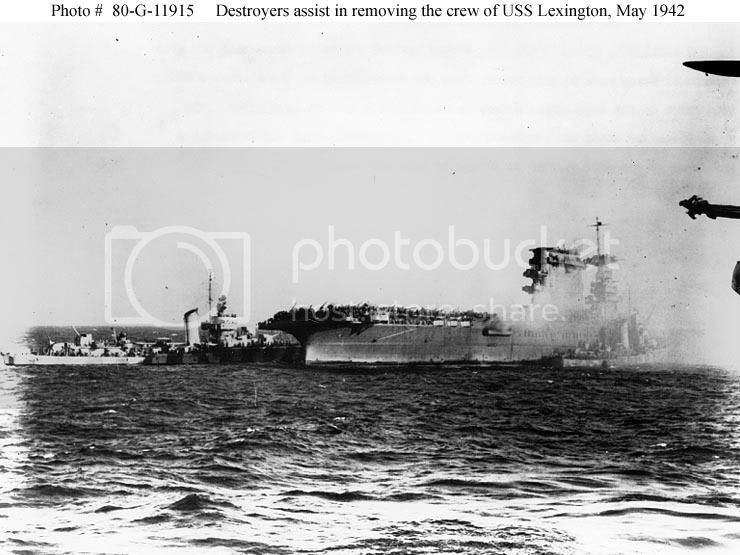

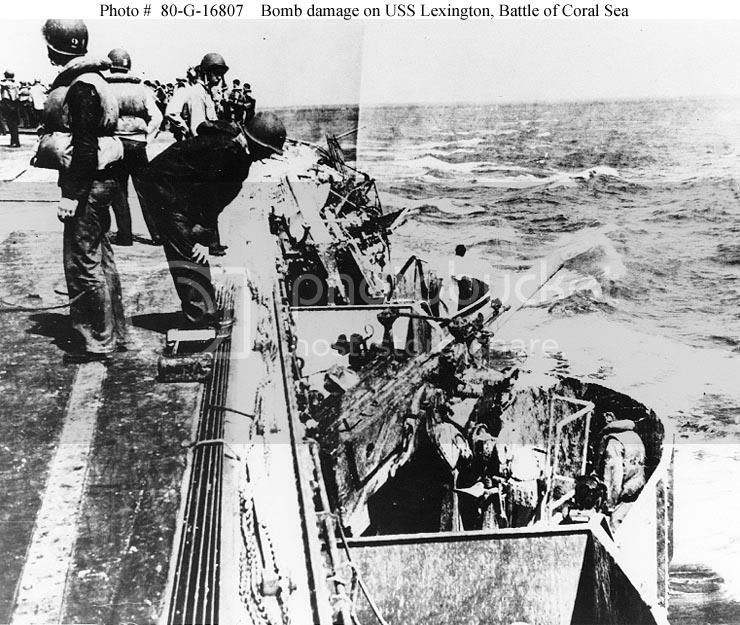


 |






